ROADSIDE REVEGETATION
An Integrated Approach to Establishing Native Plants and Pollinator Habitat
5.3 Obtaining Plant Materials
Obtaining the appropriate species, seed source, and stocktype for a revegetation project requires advanced planning and lead time. Obtaining genetically adapted materials, for example, may involve targeted collections of plant materials near or in the general geographic area of the project site several years prior to project implementation. The group of implementation guides in the following section focuses on three types of plant materials: seeds, cuttings, and plants. Section 5.3.1 covers how to determine the amount of wild seed to collect, wild seed collection methods, cleaning techniques, storage conditions, and quality testing. Methods for collecting the stems of willows and cottonwoods in the wild (as well as several other native species that propagate vegetatively) are described in Section 5.3.2. Salvaging plants from the wild and replanting them on project sites are described in Section 5.3.3.
For most projects, the collection of wild seeds, cuttings, or plants is not sufficient to meet project objectives. To increase plant materials, wild collections should be sent to native plant nurseries for propagation. Section 5.3.4 outlines the basic steps necessary to work with nurseries in establishing seed production beds for increasing seed banks of grass and forb species. Producing large quantities of cutting material of willow and cottonwood species can be accomplished by establishing stooling beds from wild collections at nurseries. This is covered in Section 5.3.5. Section 5.3.6 describes how to work with nurseries to obtain high quality bareroot or containerized seedlings.
5.3.1 Collecting Wild Seeds
Introduction
Wild seeds can be collected from native stands of grasses, forbs, shrubs, trees, and wetland plants found in or near project sites or other locations as determined via processes described in this report. The primary objective for wild seed collection is to obtain genetically appropriate, locally adapted seeds for starting nursery-grown plants (Section 5.3.6), nursery seed production (Section 5.3.4), and/or occasionally to sow directly on a disturbed site. Because seed and seedling propagation hinges on the availability of wild seeds, propagule collection is one of the first major tasks of a revegetation plan and should be initiated as early as possible while a project is in the planning stage. Depending on the purpose, the lead-time for collecting wild seeds could be up to three to four years before sowing or planting the project site (Figure 5-50). Seed collectors need to get approval from Project Engineer if harvesting is planned in ROW adjacent to an active roadway. Following safety practices near traffic). This lead-time is important because it requires multiple growing seasons to establish plants in the nursery or in grower's seed increase field.
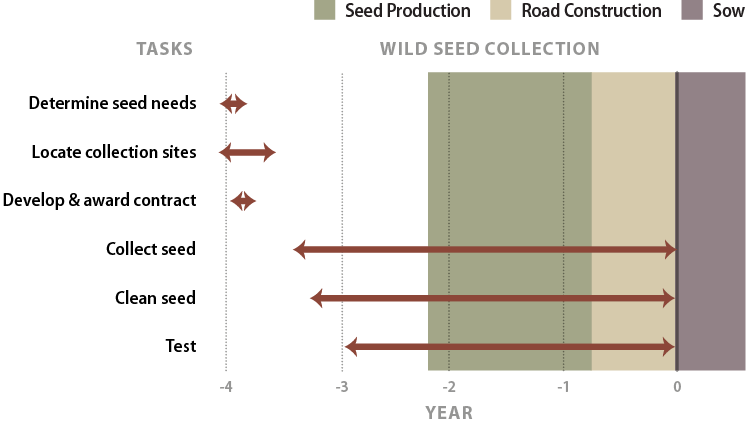
Figure 5-50 | Early planning is essential when collecting wild seeds
Wild seed collection is often one of the first contracts developed during planning. Seeds are needed to implement seed and seedling propagation contracts. A lead-time of three to four years is typically needed for wild seed collection. The time span for seed collection could be continuous up to the time of sowing depending on whether the collected seed is utilized for seed increase/plant propagation or if the collected seed is directly sown on the project site.
Grass and forb species are often seeded directly onto disturbed sites. In order to obtain enough seeds for direct seeding, wild seed collections may be "increased" in nursery production or agricultural seed fields (Section 5.3.4) depending on the size of the revegetation project. Trees and shrub seeds, however, are not typically sown directly on disturbed sites but are instead sent to nurseries for seedling propagation, then outplanted one to three years later depending on the stocktype and seedling size specifications. Seeds from wetland genera, such as sedges (Carex spp.) and rushes (Juncus spp.), are often collected for both seed and seedling production purposes.
Revegetation plans are seldom finalized before wild seeds are collected. At a minimum, planning should have identified revegetation units, described reference areas, determined species to propagate, and completed a survey of the construction site to determine the amount of area to be revegetated. The quantity and location of wild seed collection are based on these early surveys.
Collecting wild seeds can be expensive. Multiple collection trips are often needed to monitor and collect populations because each species has a small ripening window, and most species do not ripen at the same time. In addition, many species do not consistently produce seeds from year to year, requiring multiple years to generate adequate foundation collections.
Before collecting wild seeds or setting up collection contracts, it is advisable to the Natural Resources Conservation Service, determine if other genetically appropriate species seed sources are already available for the project. Often local agencies or commercial producers will have seeds in storage for many of the species growing near the project area, especially species used for reforestation.
Develop Timeline
Wild seed collection should be one of the first tasks to consider when beginning revegetation planning. Three to four years are often necessary in order to locate, collect, clean, and test wild seeds, and still allow the nursery or seed producer enough lead time for plant and seed production (Figure 5-50).
Seed collection contracts are typically awarded prior to the growing season to provide the contractor enough time to locate and assess the collection areas, source populations, and potential seed crop. Seeds are monitored periodically and collected when ripe. Wild seed harvests are cleaned, tested and certified, and stored prior to shipment to the nursery or grower for seed increase.
Determine Wild Seed Needs for Seed Production
Wild seed collection and the nursery seed increase contracts are often developed simultaneously because the information needed for wild seed collection is based on the expected seed yields of the seed increase contract. This section describes how to calculate the amount of wild seeds to collect based on the amount of seeds expected from a commercial seed producer. The designer will most likely need to work directly with the contracted seed producer to better understand the potential seed yields of a specific crop grown in a specific location.
The amount of uncleaned wild seeds to collect for seed propagation contracts requires the following information (used in the calculations in Figure 5-51):
- Seed needs
- Years in seed production
- Sowing rates
- Annual seed yields
- "Cleaned-to-rough cleaned" seed percentage
A |
Seed production needs |
22 lbs |
From seed needs plan |
B |
Years in production |
2 years |
Seed production can span several years depending on lead time of project |
C |
Sowing rates |
1 lbs/ac |
Consult with seed producer or reference tables |
D |
Annual seed yields |
50 lbs/ac/yr |
Consult with seed producer or reference tables |
E |
A / B / D |
0.22 ac |
Area seed producer needs to sow |
F |
E * C = |
0.22 lbs |
Cleaned wild seeds that seed producer needs to sow |
G |
Cleaned-to-rough-cleaned seed ratio |
33% |
Estimated |
H |
100 / G * F |
0.67 lbs |
Rough weight of seeds to collect |
Figure 5-51 | Determining wild seed needs
The quantity of wild seeds to collect can be determined from this spreadsheet. Pearly everlasting (Anaphalis margaritacea) is used in this example. For sowing rates, annual seed yields, refer to Table 5-15, Table 5-16, or discuss with the seed producer.
The quantity of wild seeds to collect can be determined from this spreadsheet. Pearly everlasting (Anaphalis margaritacea) is used in this example.
Seed Needs—The total seeds needed for each species on a revegetation project is based on the total planned revegetation acreage, seedlot characteristics (germination, purity, seeds per pound), site limitations (e.g., how well seeds will survive), and the desired seedling densities after seeds have germinated. Refer to Section 5.3.4, see Determine Seed Needs for Seed Production for methods to calculate how many seeds are needed for each species in a revegetation project.
Years in Seed Production—Every species has its own seed production characteristics. For example, species such as blue wildrye (Elymus glaucus) and California brome (Bromus carinatus) produce high seed quantities the first and second year, then level off or decline in years three and four. Species such as fescues (Festuca spp.) and Junegrass (Koeleria spp.) yield few seeds in the first year, but seed harvest levels increase to full production in the second or third year. For these species, a minimum of two years should be scheduled for seed production. Refer to Section 5.3.4, see Determine Seed Needs for Seed Production for discussion of first- and second-year yields for some commonly produced species.
Given proper storage conditions (Section 5.3.4, see Seed Storage) seeds of many species can be stored for several years or longer and still maintain good viability. For this reason, seed production does not have to occur all in one year. For projects that have several years lead time, maintaining production fields gives the designer more flexibility.
Sowing Rates—Commercial growers require a minimum amount of clean wild seeds (e.g., a foundation collection) to establish a seed increase field to produce a given quantity of seeds. While these rates differ somewhat between seed producers, general sowing rates for some commonly propagated species in the western U.S. are shown in Table 5-15 and Table 5-16.
Annual Seed Production Yields—The amount of seeds that are produced annually varies by species, geographic location of the fields, weather conditions, and experience of the seed producer. Understanding what yields can be expected from seed producers will determine how many acres will be under production. Average seed yields for some species used in revegetation in the western U.S. are presented in Table 5-15 and Table 5-16.
Cleaned-to-Rough-Cleaned Seed Ratio—Foundation seed collections from the wild can include stems, chaff, and flower parts (Figure 5-52). This material should be cleaned as much as possible by the seed collectors before it is sent to a seed extractory for final cleaning. The amount of non-seed material can be a substantial part of the wild seed collection weight. "Cleaned-to-rough-cleaned" seed ratios Table 5-13 can help calculate the extra weight of seeds to collect in the wild to compensate for seed cleaning. Dividing the desired amount of cleaned seeds by this ratio will yield the amount of wild seed that needs to be collected. This information can be provided by the seed extractory or specialists familiar with the cultivation practices of a certain species.
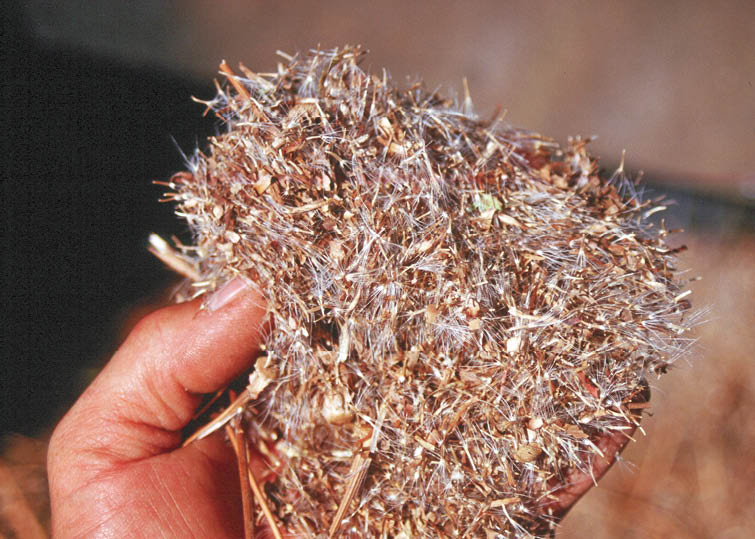
Figure 5-52 | Wild collected seed needs to be cleaned
Field-collected seeds include stems, chaff, flower parts, and seed attachments. Species such as cutleaf silverpuffs (Microseris laciniata) have a low "clean-to-rough" seed percentage and should be sent to a seed extractory for cleaning prior to sending to seed producers. The intended seeding method also strongly influences cleaning requirements.
Photo credit: David Steinfeld
Table 5-13 | Typical ranges of "cleaned-to-rough cleaned" seed recovery percentages
To obtain the amounts of "rough" seeds to collect, divide the amount of cleaned seeds needed by the "cleaned-to-rough cleaned" factor. For example, if 5 pounds of cleaned seeds of prairie Junegrass (Koeleria macrantha) are needed, a minimum of 12.5 pounds of rough cleaned seeds should be collected ( 5 / 0.40 =12.5 ) The cleaned recovery percentage can vary greatly depending on seed collection method (e.g., stripping seed versus clipping seed heads which increases trash impurities.
Chart based on Pacific Northwest Region Forest Service seed collections data.
Common name |
Scientific name |
Cleaned-to-rough cleaned factor |
Bluebunch Wheatgrass |
Pseudoroegneria spicata |
0.25 to 0.33 |
Idaho Fescue |
Festuca idahoensis |
0.33 to 0.50 |
Prairie Junegrass |
Koelaria macrantha |
0.20 to 0.40 |
Squirreltail |
Elymus elymoides |
0.20 to 0.25 |
Yarrow |
Achillea spp. |
0.20 to 0.25 |
Sandberg Bluegrass |
Poa secunda |
0.33 to 0.40 |
Blue Wildrye |
Elymus glaucus |
0.50 to 0.65 |
Determine Seed Needs for Seedling Production
The quantity of wild seeds to collect for propagating seedlings at plant nurseries will be based on an estimate of the quantity of seedlings needed, the percent seed germination, the percent seed purity, seeds per pound, and the nursery factor. An estimate of germination, purity, and seeds per pound can be obtained through published sources, seed inventories, or from seed extractory managers. The nursery factor is a prediction of the percentage of viable seeds that will become "shippable" seedlings. Each nursery has developed a set of factors based on culturing experience and practices. Nursery managers should supply nursery factors for each species or information on the amount of seeds to collect to meet the seedling order. Nursery factors are often less than 50 percent.
Using the following equation, the amount of wild seed to collect can be estimated:
Quantity of seedlings needed
[ ( % of germ / 100 ) * ( % purity / 100 ) * ( seeds / pound ) * ( nursery factor / 100 ) ]
Locate Plants in the Wild
Potential collection areas are identified during the vegetation analysis phase (Section 3.6.1). General collection locations can be established by the designer with consult of a botanist or revegetation specialist familiar with the local vegetation. Contracts often require seed collectors to identify individual collection areas for approval prior to collection.
Wildland seed collections should incorporate genetic principles and guidelines for ensuring local adaptation and genetic diversity in the resulting seedlot. These include collecting seeds from multiple, well-distributed locations within an established seed zone or other biogeographically defined area. Genetic diversity may be enhanced by collecting seeds in approximately equal quantities from approved collection areas, and collecting from a large number of widely spaced or unrelated parent plants per area (over 50 is optimal). Plant populations growing in unusually harsh or challenging environment conditions (e.g., weedy sites) may be good candidates to consider due to natural selection pressures and genetic adaptations that may produce offspring with improved fitness and competitive ability (Strauss and others 2006; Leger 2008). Within any site, generally no more than 50 percent of the seed crop should be collected in a given year, and repeated collections in subsequent years should be minimized or avoided to preserve viability of native plant population and dependent wildlife, including pollinators (Section 3.13.2).
Collection sites should be free of any plants listed as noxious weeds by the State Agency or any species on the Federal Noxious Weed List because of the potential of seed contamination. Once located, the collection sites should be documented in GPS and/or marked with flagging at a point easily visible from the road used to access the site. When seed collection is conducted outside of the project area or agency-administered lands, permission should be obtained from the landowner or manager.
Collect Seeds
For the Designer
The seed collection methods and processes described in this section require a high level of expertise and familiarity with the target species. Designers should seek input from botanists, geneticists, and revegetation specialists as needed.
Only viable seeds that are visually sound and sufficiently mature should be collected. Seeds are considered sound when the embryo has developed normally and there is no evidence of insect, disease, climatic, or other types of damage. Seed maturity in plants with fleshy fruits (many shrub and some tree species) often corresponds with changes in color (e.g., color changes from green to red, blue, purple, or white), taste (higher in sugars when mature), or hardness (fruit softens with maturity). Wind-dispersed seeds, which include many of the conifer species, usually change from green to brown when ripe. For grass species, a quick test for seed maturity can be determined by how seeds respond to being squeezed (Inset 5-12). A more effective method is to cut the seed and identify the development of the embryo under a hand lens or microscope. Because seed ripeness is influenced by the local weather and microclimate, determining seed ripeness often requires several monitoring trips to the field prior to collection.
Inset 5-12 | Stages of grass seed maturity
For grasses, the stages of seed ripening can be determined by squeezing a seed between the thumb and forefinger. The stage of seed maturity is broadly defined by the following response:
- Milk stage—A milky substance is secreted, indicating an immature seed lacking viability.
- Soft-dough stage—Seed has a doughy texture, indicating it will have low germination and viability if collected.
- Hard-dough stage—No excretion of dough or milky substance when squeezed. Seeds are collected at this stage. Seeds can be collected at the transition between soft-dough and hard-dough stages. If collection occurs between these stages, seeds should not be stripped from the plant. Instead, seed heads should be cut and placed in collection bags where seeds will continue to mature.
- Mature—Seeds in this stage are usually too hard to bite. Collection should begin immediately because seeds can dislodge from the stem at any time.
Seed collection techniques are tailored to the species being collected. Grass and forb species, for example, can be hand-harvested by stripping or clipping stems just below the seed heads and placing them in collection bags or containers. Collection containers should be made of materials that allow airflow, such as paper or fine mesh. Plastic bags or plastic containers should not be used. Other methods of collecting grass and forb seeds include mechanical flails and vacuums. While these methods can increase seed harvesting rates significantly, they should be done on nearly pure stands of a single species to avoid contaminating the seedlot with more than one species. Some forbs, such as lupine (Lupinus spp.), have indeterminate inflorescence, which means they continuously bloom, starting from the bottom of the flower head and progressing to the top (Figure 5-53). These species present a problem in seed collection because seeds ripen continuously through the growing season. Seeds from these species are often obtained by making multiple trips to the field and collecting seeds from the lower portions of the stem without disturbing the flowers or immature seeds above. Multiple collection trips may also be required if there is substantial variation in seed ripening among different type of microsites.
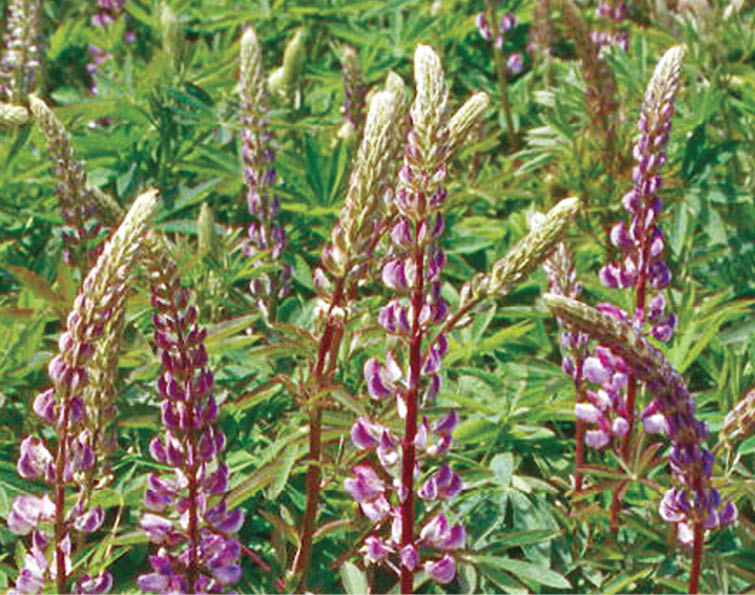
Figure 5-53 | Seed ripens throughout the season for some plant species
Species such as lupine (Lupinus spp.) have indeterminate inflorescence bloom and set seeds all summer. Seeds ripen first at the bottom of the stem and continue to ripen up the stalk as the season progresses.
Photo credit: David Steinfeld
Seeds of many shrub species are often collected by holding a bag or tray under the plant and shaking the plant or flailing the branches with a stick or tennis racket. While the seeds of some shrub species ripen and remain on the seed head, others, such as Ceanothus spp., shatter when mature and should be collected as soon as they ripen. Because multiple collection trips can be expensive, an alternative approach is to enclose the seed head of each plant in a mesh or paper bag before the seeds have begun to ripen. At the end of the season, ripened seeds will have dispersed into the bags which can be processed or transferred to other containers. Seeds or seed-bearing fruits should not be collected from the ground, although in some cases paper or cloth may be placed under the plant to catch the seeds (e.g. forbs and shrubs whose seeds shatter upon maturity). The seed collection contractor should specify the methods that will be used for collection.
For the Designer
State certification agencies can provide seed certification and other quality assurance services to agencies and other clients to help ensure that seed and plant products meet accepted standards. These services may be especially useful when an agency is unable to monitor all stages of plant material production from seed/cutting collection through seedling propagation and seed increase. Seed certification regulations and procedures are regulated by the Association of Official Seed Certifying Agencies (AOSCA).
Site location and other details of the collection can be documented on a form that includes the following:
- Species (scientific name)
- Geographic location information (GPS point) or latitude/longitude or UTM coordinates
- Date of collection
- Name of collector
- Number of populations collected
- Elevation
- Road project name
Each seed collection bag or container should be clearly identified in the field using a label similar to the Forest Service identification tag shown in (Figure 5-54). These tags are generally available at Forest Service district offices or seed extractories. To ensure the identity of the seedlot in case the tag is accidentally removed during handling or shipping, it is a good idea to duplicate the tag and place it inside the collection bag. Field collections should be grouped into seedlots prior to sending these collections to the seed extractory for cleaning. Individual collections within a species are generally only maintained as separate seedlots if the objective is genetic testing or research. The expense of cleaning, packaging, and keeping records of a multitude of collections outweighs the necessity of storing them separately.
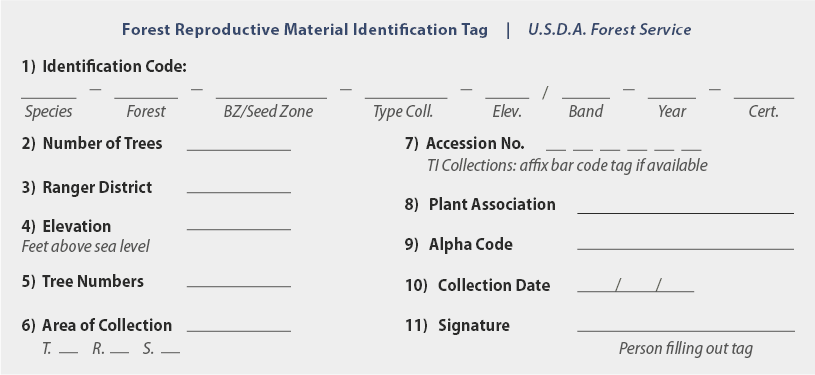
Figure 5-54 | Recording seed collection information is imperative
A plant material collection tag like the Forest Service example in this figure should be completed and attached to each collection bag sent to the seed extractory. A copy should also be placed inside the bag.
Clean and Test Seeds
Wild seed collections should be cleaned to a standard that can be uniformly applied through seed sowing equipment for seedling production or seed increase. The method of application may determine the type of cleaning required e.g. hand broadcast may need less processing than drill seeding. Seed extractories have the experience and equipment to clean wild seeds of many plant species that are frequently used in revegetation projects throughout the U.S. Seed cleaning is typically completed in two to three steps: (1) removing seeds from cones or seedpods (conifer species and some hardwood tree, shrub, and forb species), (2) detaching structures from seeds, and (3) removing all non-seed materials from collections. Removing seeds from most conifer cones involves using tumbling equipment to allow seeds to separate from scales. Some conifer species and many shrub and hardwood species require specialized equipment to break open the seedpod without damaging the seeds. Detaching seed structures involves the mechanical removal of awns (grasses) and fleshy structures, wings or other appendages. Once seed structures are detached, non-seed materials, including stems and chaff, can be removed from the collections, leaving high purity seeds (e.g., greater than 90 percent) or some user-specified level depending on the species and intended use of the particular seedlot. Seeds sown in seed increase fields with high precision equipment, for example, are generally cleaned to a higher purity level than seeds that will be hand sown or spread as mulch directly on a project site.
Seed extractories will dry, package, and store seeds, as well as test seeds on-site or send seed samples to a testing facility. It should be noted that seed extractories cannot improve a poorly collected seedlot. Seed extractories cannot completely remove weed seeds, damaged seeds, or immature seeds from a collection, nor separate seeds from different crop species mixed in a seedlot. Removing contaminants from a seedlot becomes increasingly difficult and expensive as the size, shape, density, color characteristics of the undesirable material are more similar to the seed of the target species. Prior to collecting wild seeds, it is important to contact the seed extractory manager to discuss which species will be cleaned and for what purpose. Seed extractory managers are valuable sources of information on collection and care of a variety of native species seeds.
For the Designer
See the list of Association of Official Seed Analysts (AOSA) members and their contact information.
Cleaned seeds should be tested for germination, purity, seeds per pound, and presence of noxious weeds (Inset 5-13) by an approved seed testing laboratory (Inset 5-14). Testing requires representative samples be collected from each seedlot. Seeds are usually stored in large sealed drums or bags. If there are multiple containers per seedlot, samples from each container should be drawn in proportion to the size of the container. Because the amount of seeds needed for testing may vary by species and laboratory, seed testing facilities should be contacted prior to submitting samples for special instructions. Ideally, seed sampling is conducted by a person who is trained and certified in this work, and preferably by a third party if contracts or purchasing documents are in place that contain seed quality requirements and specifications.
Inset 5-13 | Seed tests
Modified from Tanaka 1984
Seed testing is used to evaluate seedlot quality and provide information for determining sowing rates for seed and seedling production. Test results also provide a basis for determining seed costs when based on Pure Live Seeds (PLS), so are important for commercial seed trade, as well as for monitoring longevity and changes in germination or viability from harvest through cleaning and storage. Methods used for seed testing are based on rules of the Association of Official Seed Analysts (AOSA). A number of tests are normally conducted on each seedlot to evaluate physical and biological seed characteristics. See a list of AOSA Labs and their contact information.
Physical Characteristics
- Purity—Purity tests are used to determine the percentage by weight of four components: pure seeds of the desired species, seeds of other species, weed seeds, and inert matter, such as stems, chaff, scales, and small stones (Note: A purity test is based on 250 seeds and noxious seed on 2,500 seed sample). Graminoid seeds with more than 10 to 15 percent inert matter will be difficult to apply through a rotary seeder or rangeland drill. Purity tests should verify the seedlot contains no "prohibited" noxious weed seeds and meets or exceeds standards for "restricted" or "other weed seeds" according to state standards for Certified Seed. Because each state has different lists of prohibited and restricted noxious weeds, it is important to request an "All-States Noxious Weed Exam." While not prohibited or restricted by the state, some aggressive non-natives found through seed testing may still pose a threat to native plant communities.
- Moisture content—Seed moisture content for most species is determined by oven-drying. Seed samples are weighed and heated at 105° C (221° F) for 16 hours, then weighed again. Seed moisture is expressed as the percentage of the weight of the water lost over oven-dry weight. Electronic moisture meters are also frequently used but are not as accurate as the oven-drying method. They give rapid measurements when checking moisture in a large number of seedlots.
Moisture tests are important for determining the storability of seeds. Typically, seed moistures for long-term storage should be less than 10 percent. - Seeds per pound—Seeds per pound is the weight of a given number of seeds of the desired species and does not include seeds of other species or weed seeds. The method weighs 100 seeds of 8 random samples and converts the values to number of seeds per pound.
Biological Characteristics
- Germination— germination test conducted in a controlled environment is the most reliable method for testing seeds. At least 400 seeds from the pure-seed component of the purity test are used in the test. Depending on the species, the seeds are usually divided into 4 replicates of 100 seeds each and chilled (stratified) for a pre-determined period and placed on trays in controlled germination chambers. At 7-day intervals, the number of seeds that have germinated (when all essential structures appear normal) are counted (AOSA 2002).
- Tetrazolium staining—Although controlled-environment germination tests are reliable, they are also time-consuming, particularly for those species requiring chilling. A rapid method of estimating viability is tetrazolium (TZ) staining. This test is preferred if results are needed immediately or if species to be tested have unknown chilling or germination requirements, which is often typical of many native species (Rauch 2006). The TZ test requires seeds to be immersed in 2,3,5-triphenyl tetrazolium chloride. Living cells stain red as the chemical is reduced by dehydrogenase enzymes to form a stable red triphenyl formazan, which is insoluble in water. Seeds are cut and the embryos that are red-stained are counted as viable seeds. This test is useful for native species that produce seeds that are dormant and will not germinate without after-ripening (that is, seeds placed in an environment where they will continue to ripen) or without special germination enhancement treatments (stratification, scarification, gibberellic acid, etc.). In these cases, germination tests usually report out lower viability rates than actually exist. Because TZ tests measure the percentage of live embryos, they typically give a better indication of potential germination percentage. Parallel TZ and germination tests can be conducted to determine how many of the ungerminated seeds are viable or dead.
- X-ray—At least 400 seeds, divided into 4 replicates of 100, are X-rayed and evaluated for the presence of mature embryos, insect damage, filled seeds, damaged seeds, and other seed characteristics that could affect germination. X-raying is a fast and relatively inexpensive test, but not as accurate or informative as germination or TZ tests. It's also useful to conduct on a seed sample collected prior to harvesting to decisions on the timing of harvest initiation, or on post-harvest samples to evaluate the need for seed conditioning treatments to improve seed quality.
Seed viability usually decreases with longer durations in storage. Seed testing should be conducted every few years, or at least the year before it is sown, to obtain the most accurate germination information. Copies of seed tests should be retained in contract files and on seed inventories.
Inset 5-14 | Seed Processing, Testing, and Storage—USFS Bend Seed Extractory
The US Forest Service Bend Seed Extractory (Bend, OR) is dedicated to seed, and only seed. Established in 1952, the Extractory is a full service state-of-the art seed processing and storage facility for all native species, including conifers, hardwood trees and shrubs, grasses, forbs, and succulents. Their staff also provides training and consultations to designers and other revegetation specialists on seed use planning, collection methods, and seed handling, testing, and storage requirements.
Processing Seed— Prior to use or storage, wild collected seed must generally be hand-screened, stripped, or mechanically cleaned to remove impurities such as excess chaff, stems, leaves, trash, dirt, and seeds of non-target species. The Bend Seed Extractory has a complete line of specialty and small lot cleaning equipment to handle the broad array of native species that are collected by National Forests and other federal, state, and county agencies (including Federal Highway Administration and state DOTs). Each year the Bend Extractory processes 10,000-15,000 pounds of seed from more than 2,700 different species. Any seedlot size can be accommodated.
Seed Testing—After cleaning, Bend Extractory conducts seed quality testing on every seedlot, including purity, seeds per pound, percent filled seed, and seed moisture content. At the client's request, additional testing (e.g., seed viability and percent live or dead seed) can be arranged at other approved facilities.
Storing Seed—The Bend Extractory also provides storage facilities, regardless of whether the seed is cleaned in-house or by other processors. Extractory staff work with clients to select the optimum seed storage — granary (55° F), cold storage (34° F), or freezer (14 ° F). Prior to storage, cleaned seed is sealed in 6 mil plastic to ensure longevity. Stored seed can be quickly removed from inventory at any time, and shipped to other facilities or field locations at client's request.
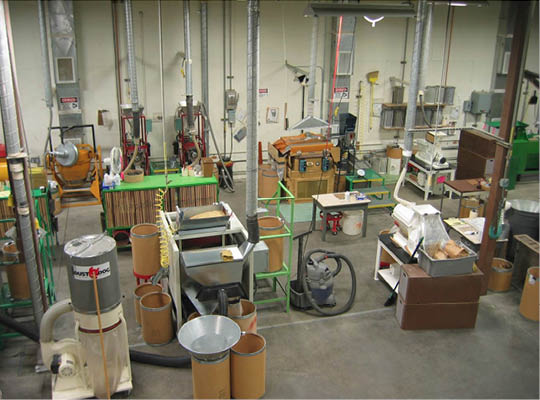
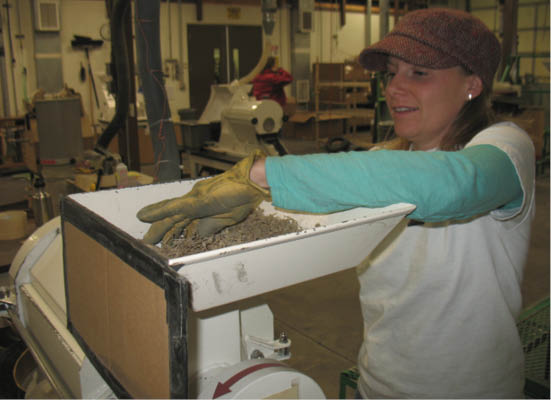
From top: Various equipment at USFS Bend Seed Extractory; Loading grass seed into a brush cleaner.
Photo credits: Jim Barner, US Forest Service
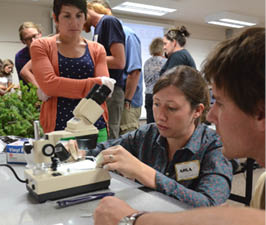
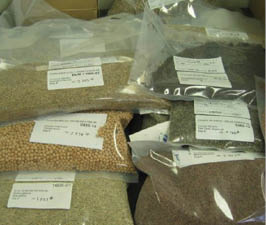
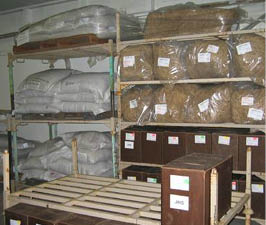
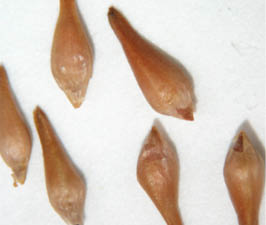
From top left: Assessing seed viability during a seed and cone training workshop; Cleaned seed in 6mil polybags; Large volume of cleaned seed in storage; Examples of cleaned seeds.
Photo credits: Phillip Chi, US Forest Service(far left); Jim Barner, US Forest Service
5.3.2 Collecting Wild Cuttings
Introduction
Using cuttings can be a viable alternative to planting seedlings or sowing seeds to reestablish native vegetation. Vegetative material is collected from stems, roots, or other parts of donor plants and directly planted on the project site or sent to a nursery to produce rooted cuttings. The potential to produce roots from vegetative cuttings varies by species—from easy to propagate to extremely difficult. The most common species propagated from vegetative cuttings are shrubs typical of riparian ecosystems and some trees. Many deciduous species that grow well in riparian settings, such as willows (Salix spp.) and cottonwoods (Populus spp.), have a high success rate when propagated from cuttings. Shrubs with characteristics desirable to pollinators include ninebark (Physocarpus spp.) and twinberry honeysuckle (Lonicera spp.). Most temperate evergreen trees and shrubs, however, only root under very controlled environments with specialized propagation techniques.
The intent of this section is to provide the designer with a greater understanding of how to select and collect cuttings in the wild. The primary focus will be on the species in the genera Salix and Populus, because these are these are most frequently used for direct planting of cuttings. With some exceptions, such as Ribes and Cornus species, most other temperate tree and shrub species should be sent to the nursery for the production of rooted cuttings before they are installed on project sites. In tropical and subtropical areas, a wider variety of species can be collected as wild cuttings. If temperate species other than willow and cottonwood are considered for propagation, nurseries should be contacted to determine the best methods for selecting, cutting, and handling the material.
Cuttings can be obtained from wild collections or from cultivated stands of donor plants, called stooling beds. Stooling beds are established at nurseries or other agricultural facilities from wild collections. In this section, the focus is on how to obtain cuttings from wild locations. The discussion of producing cuttings from stooling beds is provided in Section 5.3.5.
For the Designer
It is critical that vegetative cuttings are harvested during the period when donor plants are dormant, especially if the material is to be stored for any length of time prior to outplanting. Also remember that cuttings, like seed, are living material and must be handled as such during collection and outplanted to ensure good plant survival and growth.
Wild cuttings are used in revegetation projects when seeds or seedlings are difficult to obtain, when seeds germinate poorly in the nursery, or when cuttings are needed for biotechnical engineering objectives. Seed yields can be low for many species due to a variety of reasons, including poor pollination, disease, and insect damage. Some species, such as pinemat manzanita (Arctostaphylos nevadensis) and Pacific yew (Taxus brevifolia), produce seeds that can be very difficult to germinate in nursery environments. Other species, which include many tree species, produce seeds irregularly and there may be many years between seed crops. Some seeds are difficult to collect either because they are inaccessible (in the upper portions of trees) or the window of seed collection is very narrow (e.g., Ceanothus spp.). For these species, starting plants in the nursery from rooted cuttings may be the only viable and economical alternative (Section 5.3.6, see Select Stocktypes). Vegetative cuttings can also be very useful in biotechnical engineering projects when installed as living structures. These projects combine the physical strength of cuttings with root strength of establishing plants to increase surface and slope stability (Section 5.4.3).
When considering the use of cuttings over seeds or seedlings, the benefits should outweigh the potential limitations. Some factors that can limit the successful establishment of cutting material are the accessibility and availability of donor plants, how well the material roots (rooting potential), and how well the material survives once it has rooted. A common oversight when working with cuttings is forgetting that this material is alive and subsequently handling the material poorly during collection and outplanting. Another oversight is collecting cuttings outside of dormancy, when plants are actively growing. Neglecting either of these facts often leads to failed revegetation projects. This implementation guide covers the major factors that are important to consider when working with wild cuttings.
Develop Timeline
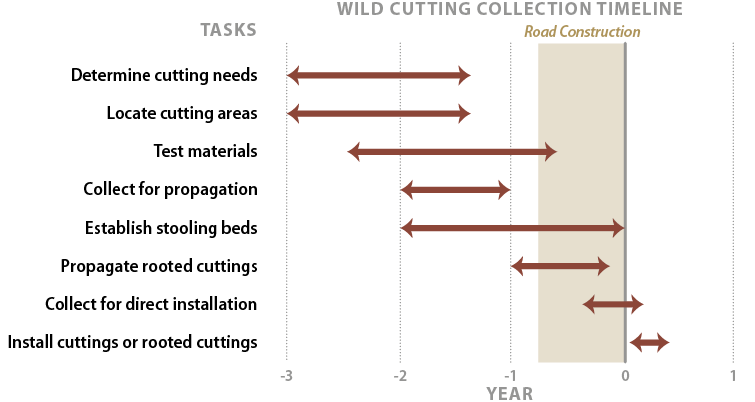
Figure 5-55 | Wild cutting collection timeline
Collecting wild cuttings requires a lead time of several years depending on whether it is used to propagate stooling beds, rooted cuttings, or direction installation.
Locating cutting areas in the field might seem like a simple task, but it can be difficult when faced with such realities as land ownership, accessibility of the cutting areas, winter weather conditions, and poor quality of plant materials. For these reasons, a lead time of several years should be considered for projects requiring large quantities of wild cuttings (Figure 5-55). On large projects, sufficient lead time allows for the location of potential collection sites and testing of the rooting potential of cutting material. If cuttings are used to propagate stooling beds (Section 5.3.5), which are recommended for large projects, cuttings need to be collected at least two years or more to establish the beds. If the material is to be used to produce rooted cuttings at a nursery, the material should be collected at least a year prior to installation. When the materials are cut for direct installation on a project site, the cuttings will be made in the fall through winter prior to planting.
Locate Cutting Areas
The vegetation assessment during the planning phase (Section 3.6.1) is an opportunity to locate potential sources of cuttings. During this field survey, cutting sites are mapped and assessed for the following characteristics:
Proximity and Accessibility—Good sources for cuttings are not always found within the project site, so it is necessary to survey over large areas within the seed zone (Section 3.13.2, see Seed Zones and Transfer Guidelines). Sometimes good collection sites are miles away from the project, which can substantially increase costs. However, the benefits of collecting quality plant materials far outweigh the additional transportation costs. The large size and weight of cutting materials often limits collections to areas adjacent to and accessible from roads. Poor road conditions during the winter, when cuttings are most likely to be collected, should be considered in site selection because of the potential of being closed by snow or winter road damage. It is often possible to collect quality cutting material within the right-of- way clearance, which is identified during the vegetation assessment.
Ownership—Some of the best collection sites may be on private lands. Always obtain permission from the landowner prior to collecting. Cutting from areas located on Federal, State, and local government managed lands should be coordinated through these agencies. Observe collection standards for size and quantity dictated by the landowners. Care should be taken not to over-harvest a source population.
Viability—The quality of the cutting material is an important criterion for determining the suitability of a collection site. Determining the viability of the collection material should be completed prior to selecting the collection site (Section 5.3.2, see Determine Rooting Potential)
Genetic Considerations—It is important to determine if the species to be collected is monoecious (male and female reproductive parts on the same plant) or dioecious (male and female reproductive parts on different plants). If the species is dioecious (Inset 5-15), such as willow or cottonwood, it's desirable to collect cuttings from both male and female plants in approximately equal amounts to promote genetic diversity and long-term species viability and sustainability. Determining the sex of donor plants is easiest during the reproductive period when floral structures are fully formed and most visible, typically early spring. (Inset 5-15). This might add an additional year to the timeline. To further preserve genetic integrity, it is recommended to collect from a minimum of 50 donor individuals within the seed zone or other biogeographically defined area (Section 3.13.2). Differentiating between genetically distinct individuals within an area can be difficult with clonal species, such as willows and cottonwoods, because what often appear as a group of individual plants are actually offshoots (ramets) of a single parent plant.
Inset 5-15 | How to tell the difference between male and female willows and cottonwoods
Identifying the sex of dioecious plants is easiest when they are flowering or fruiting. Willow (Salix spp.) catkins may appear before, during, or after new leaves appear in spring. Identifying anthers in male catkins (Image A in the illustration below) and pistils in female catkins (Image B) with a hand lens is relatively easy, especially with practice. Female plants can easily be identified when the cottony seeds are mature (Image C). During the winter dormant season, it is possible to identify the sex of dormant cottonwoods by dissecting floral buds, although this is more difficult with willows. Detailed instructions on how to sex willows and cottonwoods can be found in Landis and others (2003).
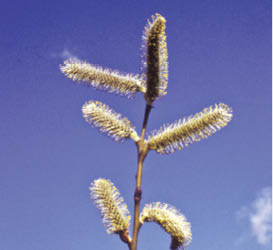
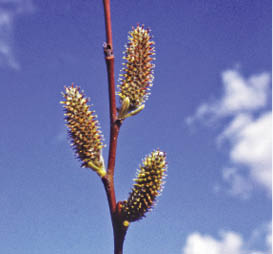
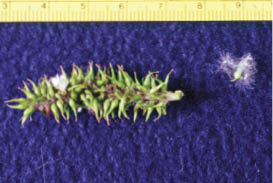
Diameter Size—The project objectives will determine which stem diameters should be collected (NRCS 1997). This should be assessed when a collection site is evaluated.
Small diameter—Small-diameter materials, called branched cuttings or whips, average less than 1.0 inch in diameter and are derived from the fine branches of healthy, dormant donor plants. This material is tied into long bundles to form live fascines (Section 5.4.3, see Live Fascines) or laid on the surface of the soil to form brush mattresses. Live fascines are placed in shallow trenches on slope contours to function like small water and sediment collection dams, or they are placed at an angle to the slope to facilitate slope drainage (Section 5.4.3). Small-diameter materials are also used for branch packing and to vegetate geogrids and rock gabions. Additionally, small-diameter materials are used for rooted cutting production at nurseries. The typical diameter size preferred by most nurseries ranges from ⅜ to ½ inch.
Medium diameter—Medium-diameter cutting materials are used to make live stakes (Section 5.4.3, see Live Stakes), which range in size from 1.0 to 3.0 inches in diameter. Stakes are tamped into the ground at right angles to the soil surface to secure small slumps, live fascines, and erosion control materials. Joint plantings are stakes that are driven between rocks or riprap and should be greater than 1.5 inches in diameter and several feet long. Materials ranging from to 2.5 inches are used to revegetate live crib walls. Crib wall cuttings should be long enough to reach 4 to 6 feet back to the end of the wall.
Large diameter—Larger-diameter materials called poles are used as dormant post plantings to stabilize streambanks. The diameter of these poles range from 3 to 5 inches and they are 7 to 9 feet long. Large poles are not always easy to obtain in the wild but can be produced from nursery stooling beds.
Cutting Footage—The total length of cuttings available for harvest should be estimated for each potential cutting area. This can be roughly calculated by evaluating 10 to 20 donor plants and estimating the average length and number of usable stems (by diameter size categories) that could be obtained from each. The average length is then multiplied by the estimated number of plants in the cutting area to obtain a total estimated cutting footage. This will be the high end of an estimate because most landowners are likely to place a restriction on the amount of cuttings that can be harvested at one time. For example, a landowner might limit the amount of cuttings that can be taken from an area to 25 percent in a riparian area. The cutting footage would be 25 percent of the total length of the cuttings.
Determine Rooting Potential
Not all cuttings will root and become established plants when installed on a project site. The success rate of those that do become plants is dependent on the percentage of cuttings that form roots when placed in an ideal growing environment (or the rooting potential) and the percentage of viable cuttings (those that root) that become established after a growing season (or the survival potential).
Rooting potential is analogous to germination percentages obtained from seed testing. Seed tests are performed under uniform, ideal growing conditions and are a measure of the potential of seeds to germinate (Section 5.3.1, Section 5.3.4, Section 5.4.1). Rooting potential is similar to germination in that it assesses the potential of cutting materials to produce roots under an ideal rooting environment. The potential of cutting materials to initiate roots is the basis for determining how many cuttings to collect and the density to plant. For example, if the rooting potential of a specific collection is low, more cuttings will need to be planted at closer spacing to compensate for those cuttings that do not root.
Root potential tests have been developed for measuring the viability of nursery-produced plants (Ritchie 1985), but there are no standardized tests for determining the rooting potential of cuttings. Labs that offer seedling quality tests might, on request, use or adapt the root growth potential tests developed for seedlings to assess the rooting potential of vegetative materials. Inset 5-16 describes one possible method for assessing rooting potential.
Rooting potential is affected by several plant factors, the most important of which are species, genotype, date of collection, portion of plant collected, age of material, condition of material, and preparation techniques.
Species—A small percentage of temperate tree and shrub species will root consistently from cuttings. Those that root well can be cut and used directly on revegetation projects. Other species initiate roots only under controlled nursery environments and should be grown into rooted cuttings before they can be planted on a project site. A list of commonly used native species in the western US that root from cuttings is provided in Table 5-14.
Table 5-14 | Common species that can be propagated from vegetative material
Species |
Vegetative material |
Rooting Potential |
|
In field |
In greenhouse |
||
Willows Salix spp. |
Stems |
Easy* |
Easy* |
Cottonwoods Populus spp. |
Stems |
Easy |
Easy |
Snowberry Symphoricarpos albus |
Stems |
Easy to Mod1 |
Easy to Mod1 |
Pacific ninebark Physocarpus capitatus |
Stems |
Easy to Mod1 |
Easy to Mod1 |
Black twinberry Lonicera involucrata |
Stems |
Easy to Mod1 |
Easy to Mod1 |
Douglas spirea Spiraea douglasii |
Stems |
Mod1 |
Mod1 |
Salmonberry Rubus spectabilis |
Stems |
Mod1 |
Mod1 |
Quaking aspen Populus tremuloides |
Roots |
Poor |
Mod |
Redosier dogwood Cornus sericea |
Stems |
Mod2 |
Mod |
Chokecherry Prunus virginiana |
Roots |
Mod2 |
Mod |
Golden currant Ribes aureum |
Stems |
Poor |
Mod2 |
Woods' rose Rosa woodsii |
Stems |
Poor |
Mod2 |
Manzanita Arctostaphylos spp. |
Stems |
Poor |
Mod |
Several species, such as S. scourleri, are difficult to root
Genotypes—Within each species, there is variability in rooting potential. Some donor plants (genotypes) will have greater rooting potential than other plants. Unless tests are conducted, it is hard to know which donor plants are optimal rooters.
Date of Collection—The optimal time to collect cutting material is during plant dormancy. For most willow and cottonwood species, this period extends from mid-fall, after the donor plant drops its leaves, to bud swell in late winter to early spring. It is safe to assume that if donor plants have lost their leaves, cuttings will be at their highest rooting potential.
For the Designer
It is important to collect cuttings either from wild sources or in a nursery setting during the dormant period of a given species.
Planting unrooted cuttings within the dormancy period is not always possible because most construction work is curtailed during winter months. If unrooted cuttings must be planted outside the dormancy period, establishment rates will significantly decrease. Several alternative measures can be taken: collect cuttings during dormancy and keep in cold storage until they can be installed (Section 5.3.2, see Long-Term Storage); collect cuttings outside the dormancy period and plant more cuttings to compensate for the anticipated attrition (Section 5.3.2, see Determine Survival Potential), or use rooted cuttings in lieu of unrooted cuttings.
Collecting plant materials outside the dormancy period has been tried in biotechnical engineering projects with varying degrees of success (Figure 5-56). Species that root easily, such as most willows (Salix spp.) and cottonwoods (Populus spp.), will root from cuttings collected outside dormancy, albeit at very low success rates (Steinfeld 2002, 2005). In some instances, however, this may be the only option available to the designer but should be considered a last resort. When these are the circumstances, collecting outside the dormancy period should be done with an understanding of how establishment rates will be affected and whether the overall project objectives will be met. For large projects, it is important to conduct rooting and survival potential tests (Inset 5-16) several years before cuttings are installed so that the appropriate amount of cuttings can be collected and planting densities can be determined (Section 5.3.2, see Determine Survival Potential). An alternative to dealing with low survival potential of wild cuttings is to establish stooling beds (Section 5.3.5).
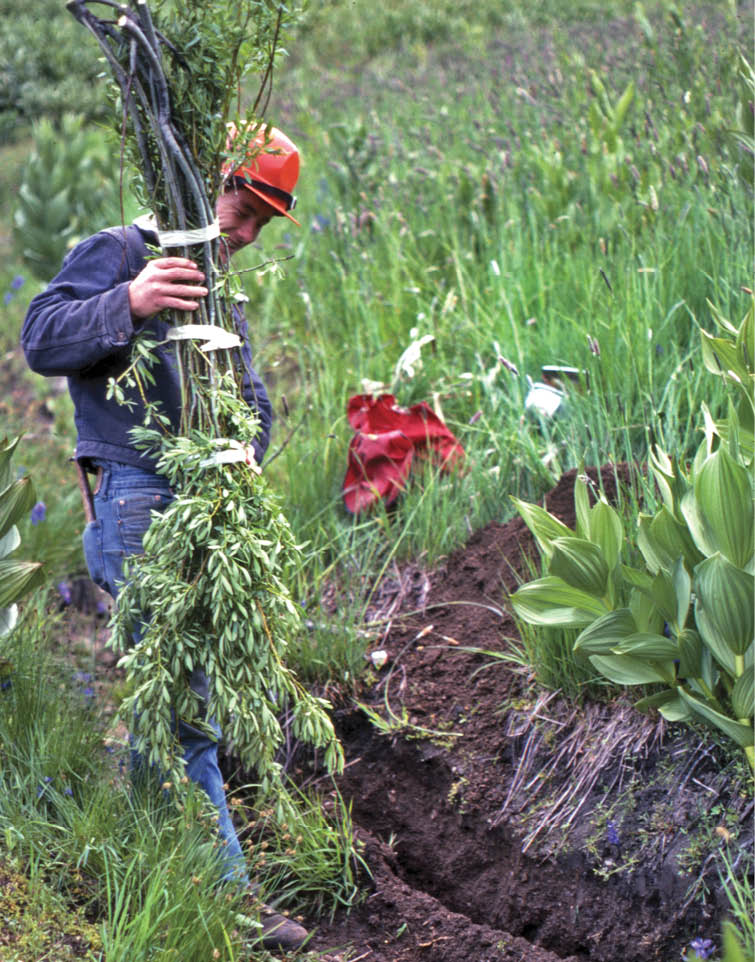
Figure 5-56 | Designers should avoid harvesting actively growing material
Collecting cuttings outside of plant dormancy, as was done for the project shown in this photograph, can lead to extremely poor results. If this practice is considered, rooting potential tests should be performed first.
Photo credit: David Steinfeld
Inset 5-16 | Testing method for determining rooting potential for willow and cottonwood species
Testing the viability of willow and cottonwood cuttings takes much of the guesswork out of establishing plants through this method of propagation. While is not a common practice in revegetation work, testing the viability of cuttings should be considered for similar reasons as seed testing. Most designers would not think of applying seeds on a project without first testing for germination, purity, and seeds per pound, yet they do not think twice about using cuttings without having tested them first. This oversight can lead to higher costs, as well as low establishment rates.
There are no established testing procedures for assessing rooting potential of cutting materials. Until these tests are established, the following means of root assessment is presented which can be used to compare results from year to year. Ideally, a controlled environment, such as a greenhouse, is the best place to conduct a rooting potential test. Temperatures should range between 65° and 75° F. Using bottom heat or rooting hormones is not necessary; in fact, for some species, it can be detrimental for rooting (Darris and Williams 2001). Where a greenhouse is not available, use an indoor space where relatively constant temperatures can be maintained. Grow lights should provide at least 12 hours of light per day.
Fifteen samples, at a minimum, should be randomly collected from different donor plants at each collection area. They should be of the same size and treated in a manner similar to what would be expected under normal operations. For example, if stakes with diameters between 2 and 3 inches are to be collected in August and soaked for 10 days before planting, then the cuttings used for the tests would be of similar size, collected in August, and soaked in the same manner, and planted. Prepare each sample by cutting them into 12-inch lengths. Stick them 3 inches apart in pots that are at least 16 inches deep, filled with 1 part peat to 4 parts perlite. Cuttings should be stuck so that two buds are exposed above the media.
After planting, water the pots and set them in their testing location. At weekly intervals, observe the cuttings and note the status of the leaves developing from the buds. At 28 days, record how many cuttings have developed new leaves, gently remove the media from around the cuttings, and lightly wash the stems. Viable cuttings should have developed roots during this period. Record how many cuttings did not initiate roots (refer to the cutting on the left in photograph below). For those cuttings that did establish roots, a quantitative estimate of root initiation can be measured by removing the roots from the stem and weighing the new roots or counting the number of new roots for each cutting.
To interpret this data, assume that any cutting that did not initiate roots or develop foliage during 28 days probably will not immediately initiate roots in the field. A comparison of average root weights or number of roots between testing samples can indicate which collection sites or treatment methods will produce the best rooting materials, or if additional sites need to be located to meet genetic guidelines and broaden diversity. Those test samples with high average root weights should perform better than those with lower weights.
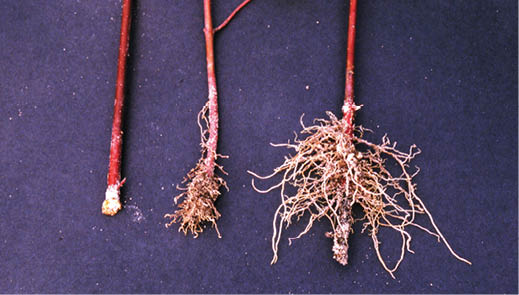
Photo credit: Tara Luna
Portion of Plant—Most cuttings are taken from stems and branches. However, the rooting potential for some species is greatest when cuttings are taken from roots (Table 5-14).
Age of Material—The rooting potential changes with the age of the donor plant. Many species have greater rooting potential from new growth, while others perform better when materials are collected from older branches or stems. Species that have a higher rooting potential in the older portions of the plant make excellent live stakes because the size of the material is often large enough to withstand being driven into the ground (Darris and Williams 2001).
Condition of Material—Vegetative material from donor plants can be affected by insects and disease, which can severely reduce rooting potential (Section 5.3.5).
Preparation Techniques—Several practices can potentially enhance rooting potential. One method involves soaking dormant cuttings in water immediately prior to planting. Schaff and others (2002) found that soaking black willow (Salix nigra) for up to 10 days in water doubled the survival rates of large diameter, dormant cuttings over unsoaked cuttings. Some designers have reported an increase in rooting potential of cuttings collected outside the dormancy period by stripping leaves from stems, while others have found this ineffective (Steinfeld 2002). Soaking cuttings in hormones can increase rooting in some species (Shaw 2004), although it can be detrimental to others (Darris and Williams 2001). Testing rooting treatments on a small scale through rooting potential tests should be conducted prior to applying these methods on a larger scale.
Determine Survival Potential
Not all cuttings that initiate roots under ideal testing conditions will establish when outplanted into field conditions on a project site. The percentage of viable cuttings that root and survive one year after planting is called the survival potential. The survival potential is controlled by climate, soils, planting methods, and maintenance practices for each project. It can be determined though field testing conducted prior to installing cuttings or estimated from previous field experience on similar sites using unrooted cuttings, rooted cuttings, or planted seedlings.
Climate—Survival potential is strongly influenced by the water loss potential of the site (Section 3.8.3). Sites with low moisture stress during root initiation (typically spring through early summer) will have high survival potentials. The longer that cuttings can initiate and grow roots without being under moisture stress, the greater the potential for survival. Climates with high humidity during root initiation occur in riparian areas.
Within a project area, survival potential often changes with aspect and microsite variation (e.g., true riparian zone verses upland zone). Cuttings subjected to hot, dry conditions of south aspects typically will have a lower survival potential than north aspects. Survival potential also increases in areas that have occasional summer rainstorms that wet the soil profile. Survival potential may decrease in more upland planting zones given the greater depth to the water table.
Soils—Survival potential is affected by soil water storage and accessibility (Section 3.8.2). Soils with low water-holding capacity will have lower survival potential than those with high water-holding capacity. Installation of cuttings on compacted soils will result in lower survival than loose or tilled soils. Areas that have high water tables during the growing season, such as slumps, seeps, and springs, will have higher survival potential for riparian species.
Installation Methods—Compensations can be made for sites with poor soils or dry climates. One option is to install longer cuttings. Studies have shown that higher survival rates and greater vegetative growth can be achieved with longer cuttings (Rossi 1999). This is especially important on drier sites, because longer cuttings can access deeper soil moisture. Cuttings up to 2 feet in length have been shown to produce better survival and growth on harsher sites (McElroy and Dawson 1986; Rossi 1999). In areas where freeze-thaw potential is high (Section 3.8.5, see Freeze-Thaw) shorter cuttings have a greater likelihood of being pushed out of the ground before they can form roots to anchor them in place. Survival rates are also affected by the quality of planting methods. For example, there can be a significant decrease in survival when cuttings are planted without good soil-to-stem contact and many large air pockets. Section 5.4.3 covers the different methods of installing cuttings.
For the Designer
Good soil-to-stem contact is one of the most, if not the most critical factor in determining high survival and plant vigor.
Plant Maintenance—Survival potential can also be increased if the plants are maintained during the first year after planting, including the control of competing vegetation and protection from animal browse (Section 5.5).
Determine Cutting Needs
Once the survival and rooting potential have been determined, the quantity of cuttings to collect can be calculated. The information needed for determining cutting quantities and cutting spacing (density) is as follows:
- Rooting potential
- Survival potential
- Target plant density
- Area to plant
- Desired established plant densities
- Length of cuttings
An example of how to calculate cutting quantities and planting spacing is shown in Figure 5-57. In this example, the project objective is to stabilize the slope by installing willow stakes. In the short term, this practice will increase slope stability by physically "pinning" the surface soil. The primary benefit to slope stability, however, will develop over time as the roots of the establishing willows begin to tie the soil particles together and increase soil strength. The desired spacing between established plants is 6 feet for most shrub species, but may be wider for cottonwood and willows depending on the site and project objectives. When inventories are taken one year after planting, there should be an established plant approximately every 6 feet (D), or approximately 303 established plants for the entire planting site (E).
A |
Area to plant |
0.25 acres |
Area that will be planted with cuttings |
B |
Rooting potential |
68% |
Percent of cuttings that root under ideal rooting environment |
C |
Survival potential |
35% |
Percent of cuttings that root which are established one year after planting |
D |
Target plant spacing (First year) |
6.0 feet |
Desired distance between established plants after one year |
E |
[ 43,560 / (D * D) ] * A |
303 plants |
Desired number of established plants after one growing season |
F |
E * ( 100 * B ) * ( 100 / C ) = |
1,271 cuttings |
Number of cuttings that need to be planted |
G |
Cutting length |
2.5 feet |
Approximate length of cuttings |
H |
F * G = |
3,178 feet |
Total footage of cuttings to collect for site |
I |
SQRT [ ( 43,560 * A ) / F ] = |
2.9 feet |
Distance that cuttings must be planted from each other |
Figure 5-57 | Determining the needed amount of cuttings
This spreadsheet can be used to calculate the number of cuttings to collect and how close to plant them on the project site.
To achieve the desired density of established plants, it should be determined how many cuttings to plant and the average spacing between installed cuttings. This determination is based primarily on the rooting and survival potential (Section 5.3.2, see Determine Rooting Potential and Section 5.3.2, see Determine Survival Potential). If these are unknown, cutting needs can be based on the desired number of plants per area, with a significant buffer added in for projected losses. In this example, the rooting potential was 68 percent based on rooting potential tests. The survival factor was estimated to be around 35 percent from previous experiences on similar sites. These factors are used in the equation shown in Line F to calculate the number of cuttings needed to install. To obtain 303 established plants, it would be necessary to install approximately 1,271 cuttings. This is approximately four times the number of established plants. It is necessary to install this many to compensate for the number of cuttings that either do not root, or that root and do not survive the summer. The planting spacing is calculated using the equation in Line I. Cuttings should be installed at half the distance of the desired established plant spacing. Because the site conditions in this example are harsh, the cuttings will need to be planted deeply to access soil moisture. For this reason, the cutting lengths are approximately 2.5 feet. Multiplying 2.5 feet by the number of cuttings needed (F) gives the total length of cuttings that should be collected (H). Knowing that 3,178 feet of cuttings are needed, the number and location of cutting areas can be selected from a cutting area map and a contract can be developed.
Long-Term Storage
If cuttings are not installed immediately, long-term storage will be required. Dormant cuttings collected in the fall or winter and stored until the following spring or summer should be held in refrigerated units. The optimum temperatures for long-term storage range between 28 to 31 ° F. Freezing temperatures prevent disease and curtail respiration, thereby increasing cutting viability. If freezing is not possible, then storing cuttings at temperatures between 33 and 35 ° F should maintain cutting viability for several months.
For long-term storage, cuttings should be relatively free of leaves and other material that might mold in storage. They should be packaged in plastic or storage bags so they will not dry out. Cuttings should not be wrapped in moist burlap, especially if cuttings are not frozen. Diseases could potentially develop that will rot the stems.
Develop and Administer Contracts
A good plan that includes the location of cutting sites and how the cuttings will be treated, transported, and stored will be the basis for the development of a collection contract. The contract should specify the following:
Cutting Locations—A map or GPS locations should identify cutting areas and specify an estimated range of cutting quantities (Section 5.3.2, see Locate Cutting Areas). If the contractor elects to collect from other areas, then these areas should be approved prior to cutting. For each cutting area, the percentage of the donor population that can be collected should be specified. Typically, this is no greater than 25 percent of the population. Donor populations should not be over-harvested.
Dates of Collection—The contract should specify a period of time that cuttings should be collected (Section 5.3.2, see Determine Rooting Potential). Collecting outside this time period should be discussed in advance with the designer.
Collection Size, Lengths, and Quantities—Quantities should be specified for each size category. For example, if material is to be used for stakes, then a specification might require 200 stakes, 18 inches long, with a range of diameters between 1.0 inch to 3.0 inches.
Collection Methods—The contract should identify how the contractor will collect the cuttings. For example, it should state how the contractor will identify which end of a stake is basal and which is terminal. This is typically done by cutting the basal end of each stake at an angle. The contract should also specify how the cuttings will be packaged or bundled. Contracts often call for all stakes to be aligned with basal ends of the cuttings in the same direction. Bundle sizes or weights should be specified. The bundles should be light enough to be transported by one person (45 pounds or less). The contract should also state that the bundles should be securely tied or bundled together for hand transportation.
Source Identification—Each bundle should be identified with an identification tag such as the seed label described in Figure 5-54, which specifies the species, collection location, elevation, and date of collection among other information.
Special Treatments—Special measures, such as soaking and use of anti-dessicants, should be stated in the contract. If soaking is required, then the location of the soaking area should be identified on a map (Section 5.3.2, see Determine Rooting Potential).
Temporary Storage and Transportation—The contractor should address how cuttings will be temporarily stored when the weather is warm or dry. Cuttings should not be allowed to dry out once they are collected. Temporarily storing in shaded areas covered by plastic sheets or wet burlap are acceptable methods. Delivery of cuttings should be done in a manner that does not allow the cuttings to dry. Closed transportation or covering with plastic for long distances should be considered.
5.3.3 Collecting Wild or Salvaged Plants
Introduction
Wild seedlings, commonly referred to as wildlings, are indigenous plants growing in their native habitat (Therrell and others 2006). They are naturally reproduced outside of a nursery but can be transplanted directly into a restoration site or into a nursery for culturing and future use.
The collection and use of wildlings in native plant restoration can be a viable alternative to direct seeding, nursery seedlings, or rooted cuttings. As with wild cutting collections (Section 5.3.2), wildlings can be used where it is difficult or impossible to collect or use seeds for plant production because of the following (Priadjati and others 2001; St John and others 2003):
- The plant either does not produce seeds or produces seeds very infrequently
- Seeds are often unfilled or non-viable
- Seeds have a very narrow collection window
- Seeds have already dispersed prior to collection planning
- Insects or animals are a problem with collection
There are several advantages to using wildlings in restoration plantings. Unlike cuttings, wildings can be available immediately with little to no transport costs, and no direct nursery costs if installed shortly after collection. They can be an effective strategy for obtaining a large number of seedlings of known origin relatively quickly. Also, large wildlings provide "vertical relief" (visual prominence) more quickly to a site than other methods and, depending on the species and environment, will establish and spread quickly (Hoag 2003). Use of wildlings reduces the risk of introducing non-native organisms such as weeds and pathogens (Therrell and others 2006). If reproduction of the plant is more successful via rhizomes (e.g., sedges), transplanting wildlings may be the most efficient and effective method for reestablishing these species (Steed and DeWald 2003). In addition, if plant propagation is difficult from seeds or rooted cuttings, use of whole plants may be the only alternative for a particular species.
Transplanting of wildling plants, however, can be unsuccessful for a number of reasons. Wildlings often grow in stressful conditions and do not recover from transplanting shock as quickly as cultivated seedlings. Wildlings often have smaller, coarser root systems than cultivated seedlings or heavier taproots that are not easily removed from soil in their entirety (St John and others 2003). Successful transplantation requires experience, skill, proper handling, ideal temporary storage, and proper care of the plant both before and after transplanting.
Develop Timeline
Although wildling plants may provide an opportunity for quick establishment of larger plants on restoration sites, several factors should be considered in the planning process that could impact their availability. Suitable locations that can provide the number of plants required should be determined. If large quantities of plants are necessary, several years may be required to identify these locations. Once sites are identified, one or two seasons of plant preparation prior to removal, transport, and transplanting may be required (Section 5.3.3, see Collection and Handling).
For the Designer
Note that removal of wildlings creates a disturbed area that may require mitigation and, at a minimum, monitoring for invasive species introduction and spread. Wildling harvest is best considered when a vegetated area is going to be impacted by construction.
Wildling plants may be removed from their native site and either transplanted immediately or transported to a nursery, potted, and cultured for future outplanting. Transplanting following removal may occur if the plant source is an undisturbed area outside the restoration site. If plants are removed prior to site disturbance or if additional time is needed for production of sturdy plants, culturing in a nursery for a specified period of time may be necessary. Lead time of one to two years may be necessary for nursery-assisted wildlings depending on the situation. This lead time may include contract procurement and administration for both collection and nursery culturing.
Locate Wildling Collection Areas
Potential sources for wildling plants can be identified through field surveys during the vegetative assessment phase (Section 3.6.1) Sites with high potential for damage to soil resources or the plants that are to remain should be avoided. Sites should be located on maps, and both plants and sites should be assessed for the following traits:
Accessibility—Proper handling of wildling plants during removal and transport is a critical factor in ensuring survival. Smaller seedlings of some species (sagebrush) may be handled successfully similar to bareroot seedlings. In other cases, roots may require protection if the rootball is not totally contained in soil. Plants may be heavy if the rootball is intact. Therefore, it is necessary that collection sites be accessible by roads. Because most collections will be taken in fall or early spring, it is also necessary to determine whether road conditions at these times of year will preclude collection.
The best collection areas may not always be found within the project site, so large areas surrounding the project may need to be surveyed for plants. Costs will increase substantially if it is necessary to transport plants for long distances.
Land Ownership—Permission to remove plants should always be obtained from either the private landowner or public land management agency. In addition, any required permits should be obtained from State or Federal agencies to ensure compliance with regulations (Hoag 2003). In some cases, environmental analyses (e.g., NEPA) may need to be completed.
Viability—If possible, areas of healthy forest or rangeland should be designated as collection sites (Priadjati and others 2001). Sites should contain healthy, vigorous, and adequately sized material with a minimum number of unhealthy plants (St John and others 2003). Stunted needles, off-color foliage, and poor annual growth are indications of stress; these plants should not be collected. Plants should only be removed from sites that show good regeneration over the area (Hoag 2003). Determining the viability of the collection material and timing of use (Section 5.3.3, see Determine Transplanting Versus Nursery Culture) should be completed prior to selection of the collection site. It is important to transplant wildlings into similar growing environments. For example, plants growing under shade should be placed back into a shaded environment to achieve optimum viability.
Genetics—One of the disadvantages or limitations of using wildlings, or any form of asexual propagation, in restoration is the potential to restrict the genetic diversity of the plant population. As adequate population sampling is important to maintain this diversity, it may be advisable to identify several sites over a large area from which to collect within the seed zone. Collecting many plants over a large area will help capture both inherited and environmental variation. However, donor sites should be chosen carefully so that they are reasonably similar to conditions of the outplanting site.
Prior to collection, it is necessary to determine whether species are monoecious (male and female reproductive structures on the same plant) or dioecious (male and female reproductive structures on different plants). If the species of interest is dioecious, both male and female plants will need to be collected in somewhat equal proportions to ensure that installed populations can persist into the future via sexual reproduction. If one of the objectives for using dioecious species is to promote, restore, or increase species, then target plants should be located when reproductive phenology is evident, which is typically spring through summer.
Determine Transplanting Versus Nursery Culture
Although cost may be the biggest deciding factor in whether wildlings are collected for immediate transplant or growing in a nursery, other factors should enter into the decision in the restoration plan.
Timing—Wildling plants should be transplanted into their new location as quickly as possible. If plants are to be collected from sites outside the disturbed area, these can potentially be removed and transplanted to the restoration site within the same time frame. However, if plant removal is part of a salvage operation where plants are located within the area of disturbance, then plants could be transported to a nursery or similar growing situation. Plants should be transplanted into pots and maintained until the appropriate outplanting season.
Species—Some plant species have characteristics that are more conducive to direct transplanting from one site to another. Plants that spread underground or with stolons will generally perform well, for example, although dry, compacted sites will slow the rate of spread significantly (Therrell 2006). Species that recover quickly from root damage, such as willows (Salix spp.) and cottonwoods (Populus spp.), will also perform well when large plants are needed quickly. These types of plants may lend themselves easily to transplanting within the same time frame as removal.
Plants with taproots, such as conifers and many shrubs, and plants with long, brittle horizontal roots, such as heather or vine maple, are difficult to transplant. Special care should be taken during removal to extract as much of the roots as possible. To ensure a higher success rate, further culturing in an optimal environment following removal may provide a healthier, more viable plant for outplanting.
Size and Availability—If wildling plants of the target species are plentiful and appropriately sized on undisturbed sites, immediate transplant during the appropriate season is feasible. However, if available wildlings are smaller than desired, an additional one or two years of nursery culture may provide a better plant for colonization of the site.
Certain plants have the ability to root by layering, such as pinemat manzanita (Arctostaphylos nevadensis). If entire plants are not plentiful, portions of individual plants can be removed and cultured in a nursery for outplanting the following year.
Collection and Handling
For the Designer
Harvesting wildlings during the dormant season can significantly reduce plant stress and increase transplant survivorship and growth.
Date of Collection and Timing of Transplanting—The season during which collection and transplanting occur has been shown to dramatically affect the survival and growth of wildling plants (Yetka and Galatowitsch 1999). Plants allocate carbohydrates and nutrients during various phases of phenological development. Different levels of tolerance to transplanting stress during the year are the result of physiological needs shifting among shoot and root growth, flowering and seed production, and storage. In addition, seasonal variation in environmental factors, such as soil moisture and temperature, can affect planting establishment (Steed and DeWald 2003).
Timing of collection will depend on whether the wildlings are to be transplanted in the same time frame or cultured in a nursery. If wildlings are to be transplanted into the restoration site following collection, the chances for survival will increase for most species if operations occur in winter to early spring. The seedlings are dormant during this period and can handle the stresses associated with transplantation. There is also less chance of damaging new roots that are initiated during the spring and fall. In addition, planting early extends the period for root growth prior to soil-drying in summer.
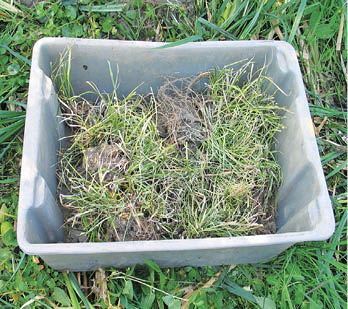
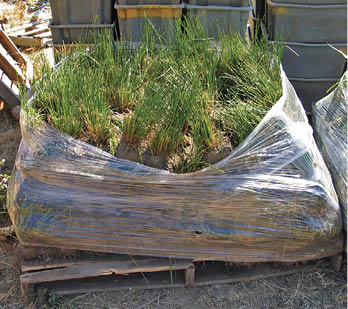
Figure 5-58 | Salvaged wetland plants
Wetland plants are often salvaged from areas that are planned for disturbance. Removing plants from wetland settings can be difficult due to wet soils and massive root systems of many species. The heavy weight of these plants makes transportation and handling difficult. Tubs (A) are used for hand-transporting to planting sites, and pallets (B) have been used for large quantities.
Photo credit: David Steinfeld
Collection could occur in either fall or spring if wildlings are to be cultured in a nursery. However, if plants are collected in the fall, care should be taken to avoid excessive root damage because plants will not be dormant. Due to the perishable nature of wildlings, the timing of collection should be coordinated with the nursery to ensure that the facilities, supplies, equipment, and labor are available following harvest (Figure 5-58) (St John 2003). Once collected, plants should be transplanted immediately into containers.
Genetics—Collection of wildlings can consist of a single plant, a clump, or several pieces of a plant that have rooted through layering (NRCS 1997). A collection of individual plants should be large enough to ensure adequate population sampling. A minimum of 50 plants from within the same seedzone as the restoration site is recommended.
Source Identification—Every collection should be identified with a tag which specifies the species, collection location, elevation, and date of collection (Figure 5-54).
Quality and Size—Only healthy, turgid, moderately vigorous and adequately sized wildlings should be collected for transplanting or nursery culturing. Unhealthy or stressed plants should be avoided.
Although species dependent, successful transplantation typically increases as plant size decreases (St John 2003). Transplantation of large shrubs and trees is usually unsuccessful. Their root-to-shoot ratio is unbalanced, and these plants often do not survive transplantation shock. Transplantation of larger willows, sedges, or herbaceous material into riparian zones, however, may be appropriate depending on the vegetative competition and other establishment conditions (Hoag 2003; Steed and DeWald 2003).
Handling, Transport, and Storage—Collection of wildling plants will be most successful if the soil is moist during plant removal. If precipitation has not occurred, irrigation prior to lifting would be desirable. Removal and transplantation should only occur in the mornings on cool, cloudy days when the plant is fully turgid.
A tile spade or similar flat-bladed shovel is the best tool for small to medium plant removal. Using the "dripline" of the plant as a guide, make shovel cuts with the blade as perpendicular to the surface of the ground as possible because maintaining an intact ball of soil around the roots is important (Figure 5-59 and Figure 5-60). Root morphology should also be considered in this process. Roots growing in deep soils or arid soils will tend to grow down rather than laterally. Roots growing in shallow soils will tend to spread laterally, requiring a much larger area of disturbance (Therrell 2006).
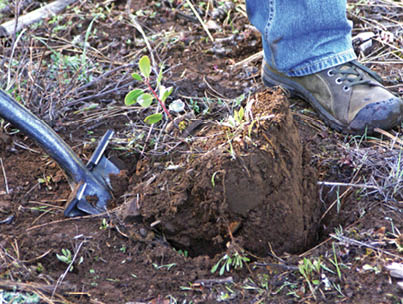
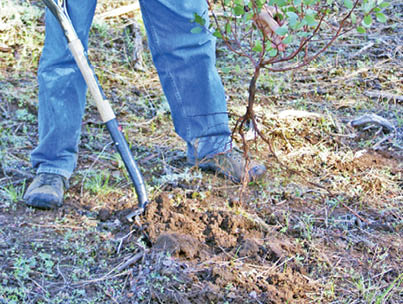
Figure 5-59 | Included soil with salvaged plants
Select small plants with a protective ball of soil around the roots (A). Do not attempt to transplant plants if the soil falls off the root system (B).
Photo credit: Thomas D. Landis
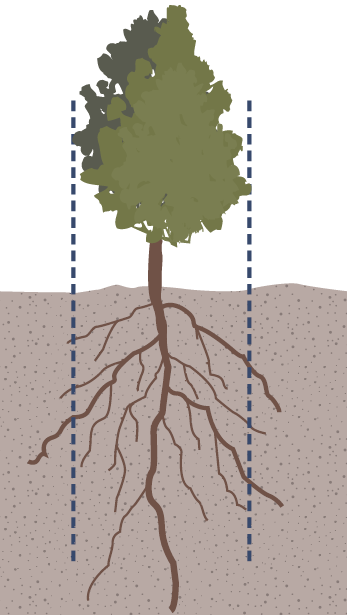
Figure 5-60 | Salvage as much of the root ball as possible
Plants can be excavated from the soil using the drip line (dashed lines) as a guide.
The shovel, and hands, can be used to lift the root ball gently out of the hole while attempting to keep the root ball intact. Hand pruners can be used to cut away woody roots that do not come free with the shovel. The root ball can then be transferred to a suitable container (large bucket, pot, burlap, or plastic bag) for transport to the transplanting site (Therrell 2006). If wildlings are to be transported to a nursery, plants should be placed in plastic bags in coolers. Plastic bags should also contain moistened towels or similar material if roots are not covered with soil.
A tree spade can be used if larger plants are to be excavated and transplanted (Figure 5-61). The factors important for using a tree spade are that the terrain is accessible to the tree spade equipment (slope gradients less than 20 percent), soils are relatively free of cobble-sized rock fragment, and soils are moist. In this operation, planting holes are created first, then plants are excavated, moved, and replanted. The size of the plant to be transplanted depends on the soil volume that can be removed by the tree spade. Typically plants up to 6 feet tall can be transplanted with success. Taller trees should be irrigated into the soil to improve survival. Using a backhoe has also been successful in transplanting large willow clumps (Hoag 2003).
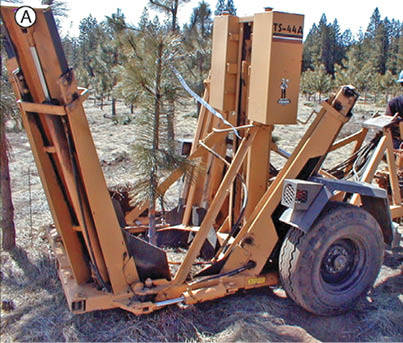
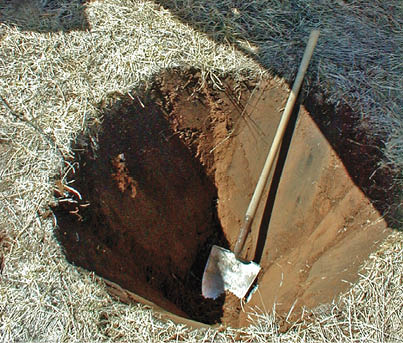
Figure 5-61 | Mechanical tree spade
Mechanical tree spades (A) can extract large plants quickly. A planting hole should be excavated prior to transplanting (B). and this can be accomplished with a tree spade.
Photo credits: Chris Jensen, USFS
Wildlings should be transplanted into their new location as quickly as possible, with minimal to no storage time. All vegetative material should be kept cool and moist during the process. If wildlings are transported to a nursery, the plants should be kept in a cooler and transplanted into pots within one to two days of collection.
Survival Potential
As with rooted cuttings (Section 5.3.2, see Determine Survival Potential), not all wildlings will become established and thrive following transplantation. Survival is controlled by climate, soils, planting methods, and maintenance practices on the project.
Climate—Water loss potential (Section 3.8.3) is probably the main determining factor for survival on many sites in the western United States. Sites with low moisture stress during root initiation (spring through early summer) and sites that have the potential for longer root initiation periods will have higher survival.
Within a project area, aspect can also affect root initiation and survival. Transplanted wildlings subjected to hot, dry conditions on southern aspects have a lower potential for survival than those on cooler northern aspects.
Soils—Survival of wildlings is affected by soil water storage and accessibility (Section 3.8.2). Soils with low water-holding capacity or compacted soils will have lower survival than those with high water-holding capacity and greater porosity.
Planting Methods—Good transplantation techniques will improve the survival rates of wildlings significantly (Figure 5-62). Planting methods are the same for wildlings and nursery-grown seedlings. Common mistakes include planting too shallow or too deep, planting too loosely, damaging roots by exposing them to air, or failing to place root systems properly (Therrell 2006).
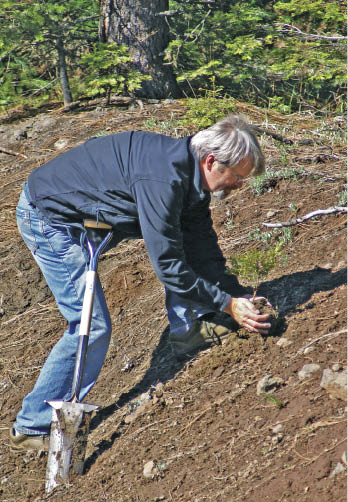
Figure 5-62 | Transplant wildlings immediately after collection
Transplant wildlings immediately following collection to minimize moisture stress.
Photo credit: Thomas D. Landis
Ideally, transplantation should occur on a cool, cloudy day. Planting holes should not be allowed to stand empty for an extended period of time, as soil will dry rapidly. When possible, microsites should be used (rocks, logs, depressions, etc.) to provide protection from the sun or wind.
Plant Maintenance—Survival potential can also be increased if the plants are maintained during the first year after planting. Such practices include the control of competing vegetation and protection from animal browse. For large wildlings, irrigation during summer will improve survival. In addition, large wildlings could need additional support depending on such site conditions as wind and snow.
Develop and Administer Contracts
A plan that includes the location of collection sites and procedures for how the wildlings will be handled, transported, transplanted, and stored (for short periods of time) will be the basis for the development of a collection contract. The contract should specify the following:
- Collection locations—A map or GPS location should identify wildling collection areas and specify a range of quantities that can be expected. If the contractor elects to collect from other areas, then these areas should be approved prior to collection. For each collection area, it should be specified what percentage of the natural population can be collected.
- Dates of collection—The contract should specify a period of time during which the collections can be made (Section 5.3.3, see Collection and Handling). Collection outside of this time period should be discussed in advance with the designer.
- Collection quality and size—Minimum and maximum plant sizes should be specified in the contract. In addition, specifications for health and vigor should be included.
- Collection, handling, and storage methods—The contract should identify how the collections will be made, how the wildlings will be handled and processed following removal, and how wildlings will be temporarily stored prior to transplant or transport to the nursery.
The contractor should address how plants will be temporarily stored when the weather is warm or dry. Wildlings should not be allowed to dry out once they are collected. Refer to Section 5.3.3, see Collection and Handling for proper handling and storage methods.
5.3.4 Nursery Seed Production
Introduction
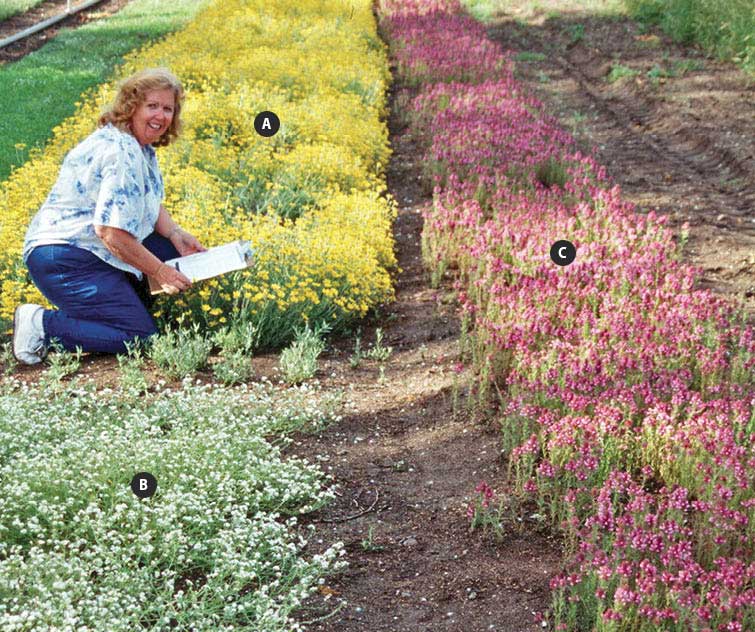
Figure 5-63 | Commercially grown native seed grow-out fields
A variety of species can be propagated for seed. In this photograph, small seedlots of forbs are being propagated at the USFS J. Herbert Stone Nursery in southern Oregon. The beds in the upper left (A) are western buttercup (Ranunculus occidentalis); lower left (B) is fragrant popcorn flower (Plagiobothrys figuratus), and the bed on the right (C) is elegant calico flower (Downingia elegans).
Photo credit: David Steinfeld
Many revegetation projects require large quantities of grass or forb source-identified seed. The most common approach to obtaining such quantities is to establish seed increase fields in nurseries or agronomic environments. Here, plants can be irrigated, fertilized, and cultured specifically to produce a large amount of seed adequate for large-scale seedings (Figure 5-63). Usually the seeds are produced by the end of the first or second year of production. The field-grown seed can then be direct sown in restoration projects, or stored in a warehouse in anticipation of future needs.
Considering the costs and amounts of seeds that can be obtained from wild seed collection, propagating grass and forb seed is very efficient. For example, mountain brome (Bromus carinatus) can require 8 pounds of wild seed to sow a 1-acre seed field. At the end of the first year, the seed collected from these fields can average 800 pounds, a hundred-fold increase. For many grass species grown in production beds for two years, the yield is at least 50 pounds of seed produced for every pound of wild seed collected and sown. In some cases, 100 pounds are collected per pound of wild seed sown. The efficiency of large-scale seed increase will vary with species, quality of starter seed, grower, and geographic region. This section outlines the steps required for developing and administering seed increase contracts.
Develop Timeline
Seed production varies by species and weather condition during production, but typically it takes three years to obtain the desired quantity of seed. This involves one year to obtain seed from wild collections and at least two years for seed production (Figure 5-64). A series of steps or tasks are required to obtain seed, which are described in detail in this section:
- Determine seed needs
- Obtain starter seed
- Develop and award contract
- Administer contract
- Store seed
Early in the planning phase a rough approximation of the quantity of needed seed for each species should be determined. Seed quantities will be refined as planning progresses, but because of the amount of time that is takes for wild seed collection and seed production, it is important to make an estimate early in the planning stages. Developing and awarding wild seed collection contracts is the first task and this can take several months (Section 5.3.4). To avoid missing the seed collection window, these contracts should typically be awarded by early spring for most species, otherwise an additional year will be needed for wild seed collection.
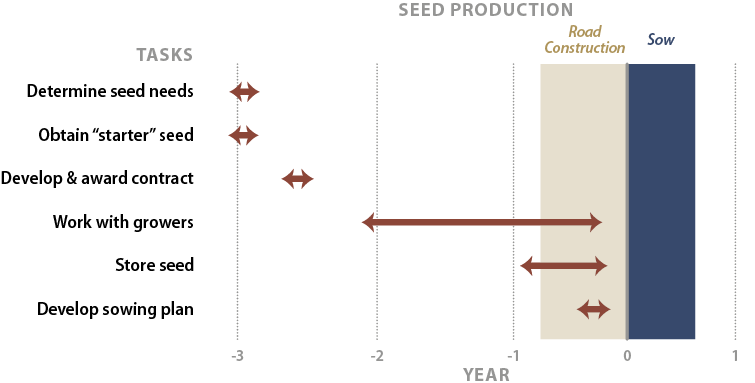
Figure 5-64 | Plan early for seed production
Up to three years should be allowed when obtaining nursery-grown seed because of the time it takes to obtain wild collected seed and obtaining seed from seed producers.
Seed production contracts should typically be awarded by mid-July for fall sowing and late January for spring sowing. It is important to prepare and award seed increase contracts well in advance of sowing to allow the seed producer enough time to prepare and sow their fields. Specific sowing dates will differ for each seed producer because of differences in geographic location, climate, or experience. If growers are certifying the seed crop through a state program, requirements that the fields are isolated from other fields of different accessions of the same species may involve additional planning and preparation time as well It is beneficial to contact the potential growers prior to award of contracts to find out when sowing and first harvests are expected. Once wild seed has been collected, cleaned, and tested, it is delivered to the seed producers.
Seed increase contracts should cover a span of at least two years to account for the possibility of a low first year harvest. Seed harvests occur during the summer and seed cleaning in the fall of each year. Once seed has been cleaned, the grower submits a sample from each seedlot to a seed laboratory for seed quality testing. Seed is placed into climate controlled storage until it is needed. If the seed that is harvested in the summer is needed for immediate fall sowing the designer should communicate with the grower to ensure that those seedlots are prioritized for processing and testing.
Determine Seed Needs for Seed Production
Determining total seed quantities for a revegetation project should be done as soon in the planning process as is feasible because wild seed collection contracts and seed propagation contracts are based on these figures. At this point, only a rough approximation of seed needs is required.
Calculating the needed quantities of seed is performed for every species that will be used on a revegetation project. Each species requires a set of data that needs to be estimated because specific seed data is unavailable at this point in planning. The information that is needed includes an estimate of the following factors:
- Pure live seeds per pound
- Field survival
- Target seedling density
- Target species composition
- Area to seed
Pure Live Seeds per Pound (PLS/lb)—The quality of wild collected seedlots can vary greatly. One method to assess seed quality is to calculate percent pure live seed (PLS). This value represents the percent of the gross seed weight composed of viable seeds. For example, if a seed producer did not clean the harvested seed of a seedlot very thoroughly, the PLS would be low because there would be a lot of additional weight associated with non-seed debris. Seedlots that were cleaned well, however, would have a higher PLS because the debris weight would have been removed. Seedlots that have higher germination rates also have higher PLS. These two factors, percent purity and percent germination, when multiplied together and divided by 100, give the PLS of a seedlot. The concept of PLS is illustration Figure 5-65. In this example, purity of a grass seedlot is 95 percent and germination is 83 percent, which result in a PLS of 79 percent.
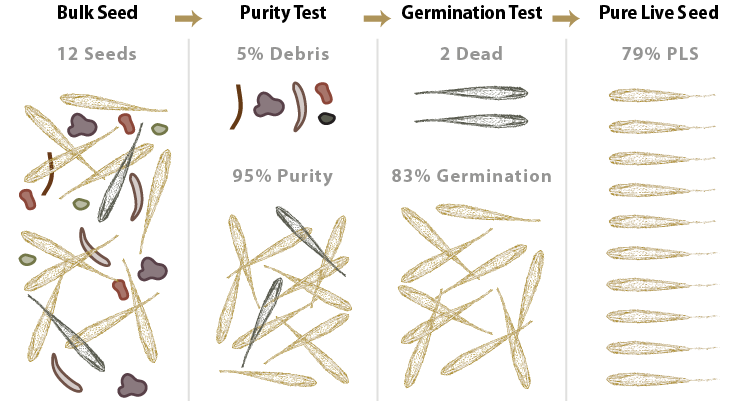
Figure 5-65 | Pure live seed
Pure live seed (PLS) is the percent of the bulk seed weight that is composed of viable seed. In this example, 95 percent of the bulk weight is composed of seed and, of this seed, 83 percent was found to germinate from seed tests. Multiplying percent purity by percent germination and dividing by 100 gives percent pure live seed.
Another example of calculating PLS/lb is shown in Figure 5-66 for western pearly everlasting (Anaphalis margaritacea). For this seedlot, the estimated purity is 60 percent, which indicates that more than half of the gross weight of seed is actually viable seed and the remaining part is either debris or non-viable seed. Multiplying this value by the percent of seeds per pound and by the percent of germination yields the number of viable seeds per pound. In this example, the number of seeds in a pound of a western pearly everlasting seedlot is tested at 8,000,000. Multiplied by 60 percent purity and 85 percent germination gives a value of approximately 4,080,000 PLS per pound of bulk seed. This value can be used in sowing calculations, as shown in the example. Note that for each additional seedlot in a mix, similar calculations will have to be made. Estimates for purity, germination, and seeds per pound can be obtained from Table 5-15, seed inventories, or seed extractory managers.
A |
Number of seeds/lb |
8,000,000 seeds/lb |
|
B |
Purity |
60% |
|
C |
Germination |
85% |
|
D |
( A * B / 100 ) * ( C / 100 ) |
4,080,000 PLS/lb |
Pure Live Seeds (PLS) per bulk pound of seed |
E |
Field survival |
3% |
Estimate of the pure live seeds that become seedlings (as low as 3 percent for harsh sites and up to 25 percent for excellent sites) |
F |
Target seedling density |
25 seedlings/ft2 |
Desired number of seedlings per square foot, all species (10 to 30 for grasses and forbs) |
G |
Target composition |
10% |
Percent of total plants composed of ANMA |
H |
( F * E ) * G = |
83 PLS/ft2 |
PLS of ANMA to sow per ft2 |
I |
( 43,560 * H ) / D |
0.9 lbs/acre |
Pounds of ANMA to sow on a per acre basis |
J |
Area to seed |
25 acres |
Total area for seed mix |
K |
I * J = |
22 lbs |
Total ANMA needed |
Figure 5-66 | Determine amount of seed needed
Determining the quantity of seed that will be needed for a revegetation project can be made by completing this spreadsheet for each species. The estimated pounds of seed determined for each species can be the basis for ordering seed through a seed increase contract. This example calculates the quantity of western pearly everlasting (Anaphalis margaritacea [ANMA]) seeds needed for a project. A spreadsheet for seed calculating is available in the Native Revegetation Resource Library.
Field Survival—Field survival factors account for the viable seeds that, for one reason or another, do not grow into plants within the year after seeding. It accounts for viable seeds that did not germinate because of the harsh site conditions or did germinate but could not survive the site. The field survival factor reflects the harshness of the site. For example, seeds that are sown under mulch on a moist, cool site will survive better than seeds sown on hot, dry sites without mulch, in which case the survival factor would be much lower. Only an estimate of field survival can be made at this time based on a general understanding of the site (Section 5.4.1, see Determine Sowing Rates). Choosing a survival factor between 3 percent (poor site conditions and poor seeding practices) and 25 percent (good site conditions and practices) should be sufficient for this estimate. In Figure 5-66, the field survival was set very low because of the harshness of the site.
Target Seedling Density—The target first-year density indicates the number of plants per square foot that is desired one year after sowing. This is the target number of seedlings for all species sown in a 1 square-foot area. Seedling densities range from a target of less than one plant per square foot for shrub and tree species to 10 to 25 seedlings per square foot for grasses and forbs (Section 5.4.1, see Determine Sowing Rates).
Target Species Composition—The target composition defines the percent of established plants that are made up of each sown species. For example, if three species are sown, the target composition of plants might be 50 percent species A, 35 percent species B, and 15 percent species C. The target species composition is developed from reviewing field surveys of disturbed and undisturbed reference sites. In the example shown in Figure 5-66, only 10 percent of the composition of plants is targeted to be pearly everlasting.
Area to Seed—This is the total area that is planned to be revegetated from seed based on the estimated acres presented in the preliminary road plans.
In the example shown in Figure 5-66, the seed needs for pearly everlasting is calculated to be approximately 22 pounds for the entire 25 acre project. This might seem like a very low amount of seed for a project of this size, but it reflects the high live seeds per pound for this species.
Table 5-15 | Seed increase reference table for native grass species
This table show the approximate maximum cleaned seed needed for a seed producer to produce a 1-acre production field. It also shows average first and second year yields and germination and purity standards for commonly produced species in the Pacific Northwest US.
Species |
Sowing rates |
Average first year yields (lbs/ac) |
Average second year yields (lbs/ac) |
Average seeds per pound |
Average |
Bluebunch Wheatgrass |
8 |
200 |
300 |
140,000 |
75/95 |
Blue Wildrye Elymus glaucus |
6 |
450 |
200 |
110,000 |
65/96 |
Bottlebrush Squirreltail Elymus elymoides |
6 |
0 |
125 |
110,000 |
75/90 |
California Oatgrass Danthonia californica |
8 |
25 |
250 |
125,000 |
75/90 |
Basin Wildrye Leymus cinereus |
8 |
25 |
160 |
130,000 |
75/95 |
Idaho Fescue Festuca idahoensis |
4 |
50 |
400 |
450,000 |
75/90 |
Indian Ricegrass Oryzopsis hymenoides |
6 |
0 |
200 |
120,000 |
80/85 |
Lemmon's Needlegrass Achnatherum lemmonii |
8 |
150 |
750 |
150,000 |
50/95 |
Mountain Brome Bromus carinatus |
10 |
800 |
600 |
70,000 |
85/90 |
Needle and Thread Hesperostipa comata |
6 |
0 |
150 |
100,000 |
50/95 |
Pinegrass Calamagrostis rubescens |
2 |
0 |
130 |
2,500,000 |
75/75 |
Prairie Junegrass Koeleria macrantha |
2 |
150 |
500 |
2,315,000 |
80/97 |
Sandberg Bluegrass Poa secunda |
3 |
300 |
600 |
1,314,000 |
75/97 |
Slender Hairgrass Deschampsia elongata |
3 |
600 |
350 |
2,000,000 |
80/95 |
Thurber's Needlegrass Achnatherum thurberianum |
5 |
0 |
150 |
225,000 |
50/95 |
Tufted Hairgrass Deschampsia caespitosa |
2 |
110 |
510 |
2,500,000 |
75/90 |
Western Needlegrass Achnatherum occidentale |
5 |
100 |
190 |
275,000 |
50/95 |
Common Yarrow Achillea millefolium |
2 |
165 |
165 |
3,000,000 |
85/98 |
Western Pearly Everlasting Anaphalis margaritacea |
1 |
50 |
50 |
8,000,000 |
60/85 |
Obtain Starter Seed
Once the seed needs for a project are determined, then the next step is to obtain starter seed to supply to the seed producer. Seed furnished to the seed producer should be of high quality and tested for purity, germination/viability (Tetrazoleum or TZ), seeds per pound, and noxious weed content (Section 5.3.1, see Clean and Test Seeds). Seedlots with high weed content will produce weedy fields. It is very expensive to weed non-target species out of seed production fields or clean non-target seeds from harvested seedlots, so it is important to give seed producers only the highest quality starter seed. It is worth the investment, and almost always essential, to send wild seed collections to a seed extractory to be cleaned prior to sending to the seed producer. Section 5.3.1, see Determine Wild Seed Needs for Seed Production describes how to determine how much wild seed to collect for starting seed production crops.
For some projects, it may be difficult to collect enough wild seed in a single year to establish a seed increase field. In these cases, the seed may be stored and additional collections made over time until a sufficient quantity of seed is obtained for field establishment. The seed may also be first sown in small plugs (1 to 2 cubic inch size) at a nursery, and then transplanted into a seed production field at low densities (<1 seedling per foot). This will reduce the overall amount of seed needed to establish a seedbed, and seed production from these beds is often greater because plants are evenly spaced.
Develop Contract
The seed production contract should state for each seedlot being grown:
- Seedlot ID
- Years each seedlot will be in production
- Minimum annual seed yields for each seedlot
- Minimum purity and germination rates
Minimum annual seed yields and average germination and purity rates can be obtained from Table 5-15 and Table 5-16. For species and regions not represented here, this information can be obtained from agencies such as the NRCS, private growers, and the Native Seed Network (www.nativeseednetwork.org). The years that a seedlot will be in production will vary by species and lead time (Section 5.3.4, see Develop Timeline).
In addition, the seed production contract should address what is required or expected of the contractor in respect to the following criteria:
- Seed production experience
- Timelines
- History of production field
- Isolation distance from fields planted with other seedlots of the same species (to avoid cross-pollination and maintain genetic integrity of the seed crop)
- Irrigation system
- Culturing practices
- Control measures for non-target species
- Seed harvest methods
- Seed cleaning, packaging, and labeling
- Seed testing
The response to these criteria becomes the basis for selection of contractors.
Seed Production Experience—Native seed production is a specialized form of agriculture requiring highly customized growing strategies and equipment. While many seed producers have transitioned in seed production easily, it still requires several years of experience with any given species to understand how to efficiently grow native seed on a commercial scale. Many seed producers who have moved into growing native seed have previous experience growing vegetable or commercial pasture and turf grass seed. These seed producers bring great experience and perspective to the native seed industry. Seed producers, who have had little experience growing native seed often start small with easier species (e.g., many workhorse species) to gain experience. It is important to know the capability of each seed producer and make frequent site visits. Those with a long history of good seed production can be contracted for species that are more difficult or have not been grown before. It is good to request production records, as well as seed tests and to include species, seed yields, seed quality, and clients served by the producer.
Table 5-16 | Seed increase reference table for native forb species
This table shows the approximate maximum cleaned seed needed for a seed producer to establish a 0.1-acre production field for key forb species in the Pacific Northwest US. Also listed is the timing and method of field establishment, field longevity, and average seed yields per 0.1 acre plot for years 1-3. A complete forb seed increase table can be obtained in the Native Revegetation Resource Library.
Species |
Seed quantity needed to plant 0.1 ac plot (ounces) |
Timing of planting |
Planting method* |
Field |
Production yield per 0.1 acre plot (lbs/year; years 1, 2 and 3) |
||
Western yarrow Achillea millefolium |
3-4 |
Summer |
DS |
3-4 |
5-15 |
30 |
30 |
Nettlelead giant hyssop Agastache urticifolia |
5-6 |
Fall |
Tubes/DS |
2-5 |
2-5 |
5-10 |
10+ |
Bigflower Agoseris Agoseris graniflora |
5-6 |
Spring/Fall |
Tubes/DS |
2-3 |
40 |
40-80 |
— |
Basin big sagebrush artemisia tridentata |
3-4 |
Fall |
Tubes |
10-15 |
0 |
10-20 |
20-40 |
Showy milkweed Asclepia speciosa |
6-8 |
Spring/Fall |
Tubes/DS |
3 |
0 |
20 |
40 |
Canadian milkvetch Astragalus canadensis |
5-7 |
Spring/Fall |
Tubes/DS |
3-4 |
0 |
20-40 |
40+ |
Basalt milkvetch Astragalus filipes |
5-7 |
Spring/Fall |
Tubes/DS |
3-4 |
0 |
20-40 |
40+ |
Douglas' Dustymaiden Chaenactis douglasii |
5-6 |
Spring/Fall |
Tubes/DS |
1-2 |
20-30 |
50 |
— |
Clarkia Clarkia spp. |
3-4 |
Spring/Fall |
DS |
1 |
30 |
— |
— |
Yellow Spiderflower Cleome lutea |
3-4 |
Spring/Fall |
DS |
1 |
50-60+ |
— |
— |
Grand collomia Collomia grandiflora |
3-4 |
Fall |
DS |
1 |
15+ |
— |
— |
Blue Muontain prairie clover Dalea ornata |
5-7 |
Spring |
Tubes |
4-5 |
0 |
20-40 |
60+ |
Threadleaf Fleabane Erigeron filifolius |
3-5 |
Spring/Fall |
Tubes/DS |
3 |
0-5 |
15+ |
15+ |
Shaggy Fleabane Erigeron pumilus |
3-5 |
Spring/Fall |
Tubes/DS |
3 |
0-5 |
15+ |
15+ |
Aspen Fleabane Erigeron speciosus |
3-5 |
Spring/Fall |
Tubes |
3-4 |
0-15 |
30-100 |
100+ |
*DS = Direct Snow
Seed Production Timelines—Seed producers are located throughout the United States that encompass a broad range of climates affecting when seeds are sown and harvested. It is important to know the general growing schedule of each seed producer in your region to determine when to supply starter seed to the seed producer and when the first shipment of harvested seed can be expected. Some seed producers wait until spring to sow seed crops, in which case the seed harvest in the first year may be significantly reduced. Depending on the climate and species, seed harvests can occur as early as May to as late as August. It is important to specify a date in the contract when seed will be delivered, especially if the seed will be used in the same year it is harvested.
History of Production Fields—Every field will have some amount of residual seeds from previous crops that will germinate along with the starter seed supplied by the designer. Knowing the history of the fields during the planning stages helps determine whether these non-crop plants pose a problem for seed production. Noxious weeds or undesirable non-native species are a concern, but many of these species can be rogued out of the seed beds prior to harvesting. Of more concern are fields where the same native species, but from a different seed source (especially from a different climate), were grown. For example, a field is being prepared for sowing California fescue (Festuca californica) from a seed source in the Blue Mountains of northeastern Oregon. The field had previously grown California fescue from a seedlot collected west of the Cascades. Because seed from the previous fescue crop would germinate in the same bed, the resulting crop would include both seedlots. Because the plants from these seedlots would appear almost identical, it would be impossible to weed out the plants that came from the previous crop. Even species in the same genera are difficult to distinguish by untrained weeders and cannot be weeded out of beds.
Fields that previously produced seed from the same or similar appearing species should be evaluated for the risk of seed contamination from previous seed crops. Seed producers can take measures to reduce contamination risks. These include growing non-seed crops for several years between seed crops, rotating between grass and forb seed production (forb seed is easy to discern from grass seed), and fumigating between seed crops. These strategies should be discussed with the seed producers. State seed certification guidelines and standards are becoming increasingly available for many native species.
Location of Other Seedlots—Equally important to the history of seed production fields is the location of nearby seed crops of the same species. If seedlots of the same species are being grown close by, the risk of cross-pollination between crops increases and the genetic integrity of the proposed seed crop could be compromised. There can even be cross-pollination between similar species. For example, blue wildrye (Elymus glaucus), bottlebrush squirreltail (Elymus elymoides), and bluebunch wheatgrass (Pseudoroegneria spicata) are known to cross-pollinate. Local botanists or geneticists should be consulted about which species can potentially cross breed. Seed crops that can cross-pollinate should also be separated by a minimum isolation distance. Under most circumstances, the isolation distances should be in accordance with State Certification Standards (certified class). These standards can be found at the AOSCA website or the departments of agriculture for each state. State seed certification specialists can often provide recommendations for species of interest that lack official isolation standards.
Irrigation System—Many native species should be grown under irrigation to meet the quantities of seed specified in the contract. Seed producers that have minimal or no irrigation capacity are often unlikely to meet seed production requirements and time frames. Only those species that do not require irrigation should be offered to growers lacking irrigation systems.
Culturing Practices—A review of culturing practices, which include irrigation, fertilization, disease, and insect control, should be done to determine whether they are appropriate for the production of the species being grown. Culturing practices are often written up in propagation protocols that can be found on the Native Plant Network. Many university nurseries and NRCS Plant Material Centers also publish propagation protocols and useful plant guides and fact sheets.
Control Measures for Non-Target Species—Specific attention should be given to how weeds and other non-crop species will be controlled. Typical measures include the use of herbicides prior to sowing and after the crop has been established, and manual weeding of non-target species. The most important period of weed control is just prior to seed harvest because of the importance of eliminating potential non-target seed before harvesting occurs.
Seed Harvest Methods—Most seed harvests are conducted with specialized equipment that detaches seed from the stock, separates it from plant and soil debris, and collects it into storage containers (Figure 5-67). It is important to know the seed harvesting equipment that will be used for each species and how it will be cleaned between individual crops to prevent the possibility of contamination among seedlots.
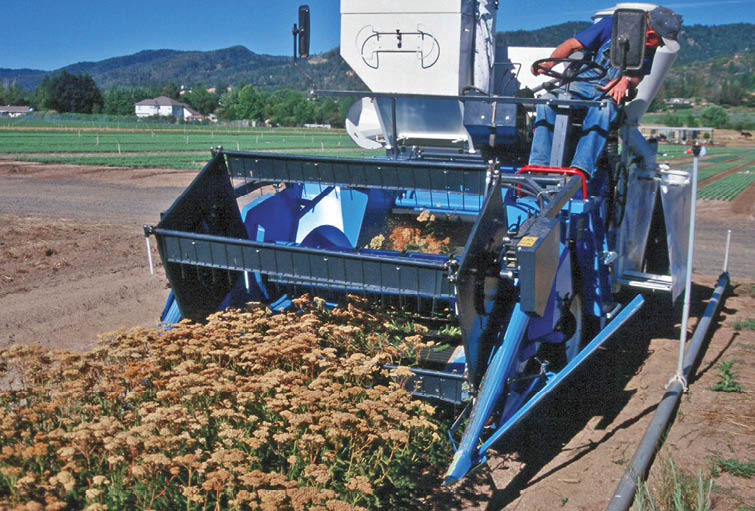
Figure 5-67 | Seed harvesting equipment
Seed harvesting equipment varies by seed producers and species being harvested. Discuss with the seed producer how each species will be harvested and make sure that equipment is cleaned between seedlots.
Photo credit: David Steinfeld
Species with indeterminate inflorescences (seeds that ripen on the seed stock all summer long) should be collected more than once in the summer. This repeated harvest can be done manually or with specialized equipment such as motorized leaf blowers that are operated in reverse as vacuums. Periodic seed harvests of these species should be planned so that the full range of seed can be collected. The designer should anticipate higher financial costs for indeterminate species given the extra harvest efforts. The seed producer should address how these species will be harvested to obtain the maximum seed yield.
Seed Cleaning, Packaging, and Labeling—After seed is harvested, it should be dried and further cleaned. Seeds are air dried (Figure 5-68). Seeds are then extracted and cleaned. Awns and flower parts are removed, and then dirt, stems, and other debris are separated from the bulk seed. Understanding the cleaning operation is important because viable seeds can be damaged or discarded during this process.
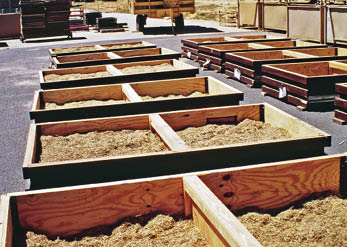
Figure 5-68 | Seed harvesting and drying
Seed is harvested and dried prior to cleaning and storage. This photograph shows a recently harvested seedlot in drying trays prior to being set on a forced air drier. Seed ID tags are attached to the side of each seed drying bin.
Photo credit: David Steinfeld
For typical warehouse storage, dry cleaned seed should be packaged in "breathable" woven poly bags at uniform weights Industry standards are 25- or 50 pound bags. Bags of seed should be clearly identified with an affixed tag stating the species name (scientific and common), seedlot identification/source code, percent germination, percent purity (including other crop seed, weed seed, and noxious weeds), date of seed test, and seed producer's name. Additional certification tags or labeling information may be requested, such as project name, National Forest or BLM office, or seed owner name.
Seed Testing and Acceptance—The contract should state the minimum acceptable standards for each species and seedlot. Acceptance and payment should be based on meeting the standards set for the following:
- Germination
- Purity
- Weeds
- Moisture content
Seed testing is typically the responsibility of the contract grower. Seed samples used for testing and contract performance should be taken by a certification agency representative or a contract inspector who is trained and certified in proper seed sampling methodologies. Samples should be tested by a state certified seed laboratory (Section 5.3.1, see Clean and Test Seeds) Seed test results should be identified by the seed source identification and task order number. Test results should be satisfactory to the project's owner agency before final acceptance of the seed is made.
Establishing minimum germination and purity rates can be based on averages obtained from commonly produced species shown in Table 5-15 and Table 5-16 and other available sources, or through discussion with seed extractory managers. The contract should address what actions the contract- grower can take to increase either germination or purity if these rates fall below the standards. Lower purity rates can be accepted if seed will be used in a hydroseeder (Section 5.4.2). A TZ test may be made in lieu of a germination test for a seed viability test depending on time constraints and species involved. All State Noxious Weed examinations are required, and if any of these species are present, then the seedlot should either be rejected or re-cleaned. The seed moisture test should also be conducted, and seed should not exceed 10 percent moisture.
Administer Contract
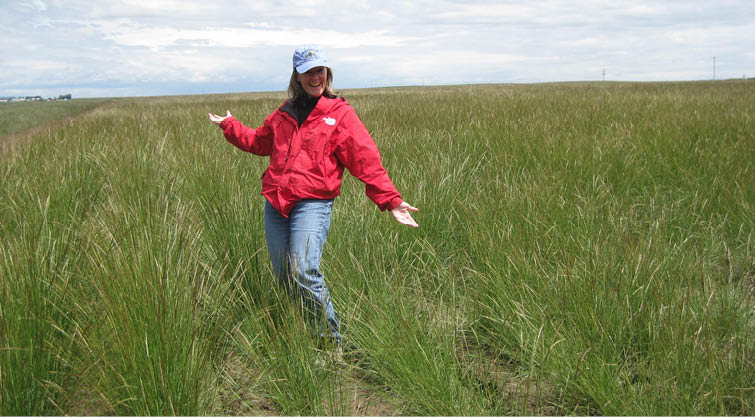
Figure 5-69 | Visit seed producers to assess crop quality
It is important to visit seed producers to assess isolation distances, noxious weeds, culturing practices (e.g., irrigation, fertilization), and expected seed yields. The best time to visit is during seed ripening and seed harvest.
Photo credit: Marlo Fisher, USFS
Seed producers are required to maintain adequate records to allow the Government to monitor contract progress. Records should include information and dates of field preparation, seed sowing, field treatments, fertilization, seed harvest, cleaning, storage, seed yields, and any other activity relating to seed production. It is a good practice to make contact either by phone or by visiting the seed producers two to three times a year to go over the progress of the contract. The best time of year for field visits is just prior to or during seed harvest (Figure 5-69). A visit or phone contact in fall is important to discuss the potential of keeping seedlots additional years. Visiting in the late summer or fall is also a good time to observe the seed extraction and cleaning processes. Unless it is stated in the contract, seed production fields are likely to be plowed under once the seed orders have been met. If seed in excess to the order is produced, contracts often specify that the Government has first right of refusal for the additional amount, often at a reduced or negotiated price.
During these visits, it is important to note the condition of the seedlots and how they are being identified throughout the production phase and subsequent processes. Are there clear labels stating the seedlot identification in the field, during drying, extraction, and storage? Are seed harvest and extraction equipment being thoroughly cleaned between seedlots or are there remnant seeds remaining in the equipment that can contaminate the next seedlot being processed? Note the condition of the fields prior to seed harvest. Are the fields weedy and will there be a final weeding before harvest? Are seeds being handled with care or are they roughly handled? These same questions and practices are also used during the state seed certification process.
A good working relationship with the seed producer is essential in meeting the overall seed increase objectives. It should be realized that some factors, such as weather, are beyond the control of seed producers, and in some years seed harvests will fall short of the minimum amounts stated in the contract. Good communications with the seed producer will allow designers to learn of crop failures or fall down in orders as soon as they occur so that alternative measures can be taken. An inventory of the number of acres in each seedlot and the condition of the crop should be supplied by the contract grower upon request.
Seed Storage
Seeds can remain viable in properly controlled storage for many years after harvest. How well seeds keep depends on the moisture content of the seed, the quality of the seed being stored, the storage conditions (temperature and humidity) and presence of damaging agents such as rodents, insects, or mold). Seeds typically store poorly when seed quality is low, or seed moisture content is above 10 percent. Fluctuating temperatures will also shorten seed longevity. If seedlots are stored for more than a couple of years, it is important to periodically test the seed for germination.
Granary Storage—Most seedlots are stored for short periods before they are used on projects (usually less than five years). For this reason, granary storage is the most common and economical form of seed storage, especially for larger quantities of grass and forb seed. Granary storage units are enclosed rooms sheltered from rainfall and temperature extremes. Storage temperatures are ideally near 10° C, with humidity less than 20 percent. Storage containers are typically insulated and protected from rodents and insects. While some seedlots can be stored for long periods, low quality seed should be used first because it is more likely that this seed will lose viability in storage compared to high quality seed.
Freezer or Refrigerator Storage—Freezer storage (~9° C) is usually reserved for seedlots that will be stored for many years. Conifer and shrub seeds, as well as small forb and grass wild seed collections, are usually stored under these conditions. Berries, however, cannot be frozen, as the moisture content may be too high and could damage the seed embryo. Instead, berries are best stored in refrigerators at temperatures ranging from 1 to 3 degrees C. Seed of some species, such as maples, also need to be stored in refrigerated conditions but may require special pre-treatments, even for short-term storage.
Seed extractory managers are excellent sources of information for more detailed guidance on proper storage conditions for particular species.
5.3.5 Nursery Cutting Production
Introduction
Obtaining cutting materials in the wild for restoration and bioengineering applications can be a difficult and expensive task, especially if populations of parent material are small or access is limited. Native plant nurseries can be an alternative source for a variety of woody cuttings. Understanding how nurseries establish and manage "stooling beds" can be a great help to designers and project engineers.
What are Stooling Beds?
"Mother plants" are established in nurseries for the sole purpose of providing a ready source of cuttings. Stooling beds are hedge-like rows of mother plants that are established in bareroot nurseries or in vacant fields (Figure 5-70A). Stooling beds are more commonly referred to as "cutting beds".
Stooling beds take advantage of the ability of many broadleaved woody plants to sprout profusely from the base after being cut off just above the root crown (i.e., coppiced). Plants remain in the juvenile state, which means they have a higher tendency to sprout and produce roots. Once stooling beds are established, annual cutting ensures that juvenility can be prolonged for multiple years. After repeated harvests, stooling beds will lose productivity after a few years. However, new beds can be created using cuttings from declining beds such that the unique genotypes in a given bed can be preserved for many years.
Stooling beds allow for the efficient collection of dormant hardwood cuttings during winter when it may be difficult or impossible to make field collections (Figure 5-70B). Because the beds are located in agronomic settings, they can be irrigated and cultured; processing and storing the cuttings is also much more efficient and cost-effective. Cuttings from stooling beds have several advantages over wild collected cuttings.
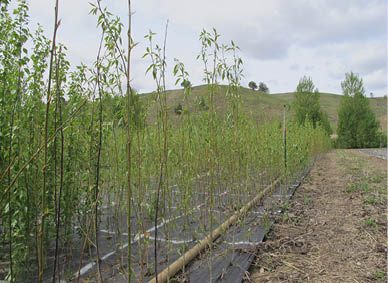
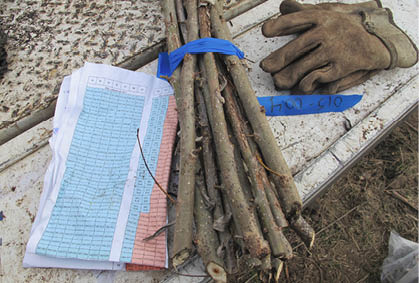
Figure 5-70 | Stooling beds produce cuttings
Stooling beds (A) are an efficient way of ensuring that a ready supply of hardwood cuttings of the proper species and source are available (B).
Photo credit: Matt Horning
Maintaining Genetic and Sexual Diversity—It is much easier to correctly identify different plant species and ecotypes from labeled stooling beds as compared to wild collections. For example, willows often grow together along streams and can be difficult to identify during the winter dormant season. Stooling beds offer the ability to produce a large number of cuttings of unique species or ecotypes quickly and easily.
Many government nurseries have established stooling beds of the species and ecotypes that are adapted to local seed zones areas and can thus be a potential source starter material for private growers or out-planting materials for designers. Private native plant nurseries also establish stooling beds of desirable species for their local areas, and several specialize in riparian and wetland species. For specific revegetation projects, however, the odds of a nursery having existing stooling beds of the proper species and local ecotype are low. Therefore, collecting cuttings and establishing stooling beds should be done early in the planning process so a good supply of cuttings will be available when needed.
Some plants, such as willows and cottonwoods, are either male or female, which is an important consideration in restoration (Landis and others 2003). If a balanced mixture of male and female plants is not collected from the project site, the resultant stooling beds will not produce both male and female cuttings. When working with dioecious plants, the sexual identity of potential mother plants should be determined prior to collection (Section 5.3.2). It is essential that a restored population is contains a mix of female and male plants to ensure the established population's capacity for sexual reproduction.
Producing Healthy and Vigorous Cuttings—One of the most practical advantages of establishing stooling beds is that the cuttings from the beds are often healthier and more vigorous than those collected from the project site. Wild stands of willows are host to many insects and fungal pests, such as galls and cankers (Figure 5-71). They are also subject to animal browsing. These factors can significantly lower the quality of wild-collected cuttings. Cuttings from the stooling beds can root at over 99 percent, thereby lowering establishment costs and keeping the project on schedule (Dumroese and others 1998).
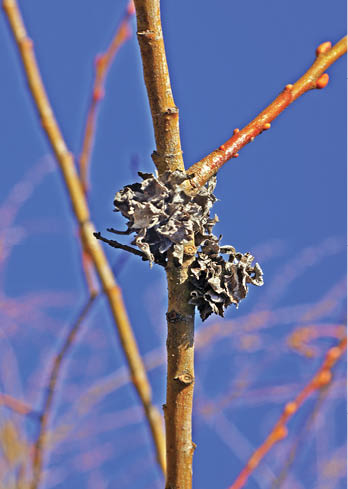
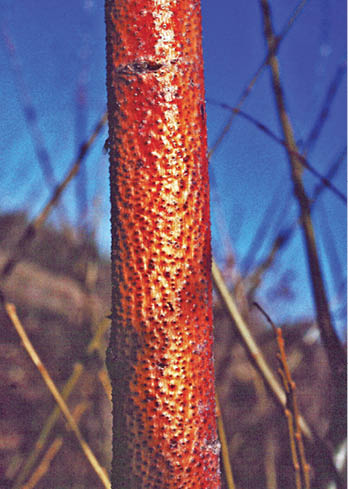
Figure 5-71 | Stooling beds are managed production facilities
Stooling beds can be cultured to prevent the occurrence of insect galls (A) and fungus cankers, such as Cytospora spp. (B).
Photo credit: Thomas D. Landis
Reducing Costs—It might seem that collecting cuttings in the wild would be the least expensive means of obtaining cutting materials. This is not necessarily the case. Inefficiencies of driving to remote locations, pulling cutting materials to roadways, using make-shift cutting practices, and working under severe winter conditions all add up to high costs per cutting.
Select Species Suitable for Stooling Beds
Poplars, cottonwoods, and willows are the species most often used in stooling beds. It should not be assumed, however, that all species of the willow family are good candidates for stooling beds. Some species have growth characteristics that reduce their potential. For example, trials at the Colorado State Forest Service Nursery in Fort Collins have shown that narrowleaf cottonwood (Populus angustifolia) and narrowleaf willow (Salix exigua) do not "stool" well and should be propagated by other methods (Grubb 2007).
There is great potential for using other woody species that have the propensity to sprout and form roots easily. For example, redosier dogwood (Cornus sericea) is commonly grown in stooling blocks and used as a source of cuttings for restoration sites. Outplanting success is higher than with wild cuttings collected on the project site and has ranged from 50 to 90 percent (Hoag 2007). In North Dakota, twinberry honeysuckle (Lonicera involucrata) is being investigated (Morgenson 2007). Native species that root easily from hardwood cuttings have the potential to be grown in stooling beds to generate cuttings. Species that have inherent deep seed dormancy characteristics, such as snowberry, honeysuckle, elderberry, and some species of currants, could be more easily propagated in the nursery using stooling beds than sowing seeds to produce seedlings. Species that have consistently low seed viability, such as mock orange and ninebark (Physocarpus spp.), may also be produced more economically in stooling beds.
The Plant Materials Centers of the NRCS identified the potential of a wide variety of woody native plants that would be suitable for stooling beds (Table 5-17). For example, Crowder and Darris (1999) discuss which plants are suitable in the Pacific Northwest and provide a wealth of information on the installation and culture of stooling beds.
Darris (2002) performed extensive greenhouse and field trials to test the potential of several woody plants for live stake applications. Common snowberry (Symphoricarpos albus), salmonberry (Rubus spectabilis), Pacific ninebark (Physocarpus capitatus), and twinberry honeysuckle (Lonicera involucrata) have proven to be effective as live stakes for soil bioengineering in the Pacific Northwest. Notably, several have proven to be superior to willow on some sites, such as salmonberry in wet, shaded environments, and snowberry on drier, exposed locations.
Table 5-17 | Native woody plants of the Pacific Northwest with potential for propagation in stooling beds
Species |
Rooting ability |
Growth rate |
Establishment success |
Coyotebursh Baccharis pilularis |
Fair to Good |
Moderate |
3 |
Redosier dogwood Cornus sericea |
Good |
Fast |
3 |
Indian plum Oemleria cerasiformis |
Poor to Good |
Moderate |
1 |
Pacific ninebark Physocarpus capitatus |
Good to Very Good |
Moderate to Fast |
4 |
Lews' mock orange Philadelphus lewisii |
Fair |
Moderate |
1 |
Black cottonwood Populus trichocarpa |
Fair to Very Good |
Very Fast |
3 |
Woods' rose Rosa woodsii |
Poor to Fair |
Moderate to Fast |
1 |
Peachleaf willow Salix amygdaloides |
Excellent |
Very Fast |
5 |
Narrowleaf willow Salix exigua |
Very Good |
Fast |
4 |
Arroyo willow Salix lasiolepis |
Excellent |
Very Fast |
5 |
Scouler's willow Salix scouleriana |
Good to Very Good |
Very Fast |
4 |
Rose spirea Spiraea douglasii |
Very Good |
Fast |
4 |
Common snowberry |
Very Good |
Fast |
4 |
Modified from Crowder and Darris (1999)
Select the Type of Cutting Material
Several different types of cutting materials can be collected from stooling beds. Nurseries can use small propagation cuttings (perhaps short as one inch) to start their own bareroot or container plants. Stooling beds can also provide several types of unrooted cuttings used in restoration (Figure 5-72).
Live Stakes—Live stakes are so named because, in addition to providing stability on restoration sites, they are expected to root and sprout after installation (Section 5.4.3, see Live Stakes). Because they are often pounded into the ground, live stakes are cut from relatively straight sections of second- or third-year wood. Live stakes are typically 18 to 24 inches in length and from 1 to 3 inches in diameter (Figure 5-72A). Depending on the plant species, it can take two to four years for a stooling bed to produce large enough branches for live stakes. Some of the smaller willow species will never grow large enough.
Whips—Whips (not shown in Figure 5-72) are similar to live stakes except they have a much smaller diameter of less than an inch. Whips can be planted by "sticking" them directly in the ground. Because of their small diameter no tools are necessary to install them.
Branched Cuttings—Bioengineering practices, such as live fascines, waddles, vertical bundles, brush layers, and pole drains (Section 5.4.3) require a large number of branched hardwood cuttings (Hoag and Landis 2001). The size of this material ranges from 0.5 to 2 inches in stem diameter and 4 to 15 feet in length (Figure 5-72B). Stooling beds may take two or more years to produce significant numbers of harvestable branched cuttings.
Pole Cuttings—Pole cuttings (Figure 5-72C) are large diameter (3- to 6-inch) main stems that have all side branches with the top 1 to 2 feet of stem removed. They are used in restoration projects where stability is a main concern. Because of the large size of the plant material necessary for pole cuttings, nursery stooling beds are ideal. Larger trees, such as cottonwoods and tree-sized willows (e.g., Goodding's willow [Salix goodding]), have primarily been used for pole cuttings. Other large woody plants with the potential to sprout may also prove to be viable material (Dreesen and Harrington 1997).
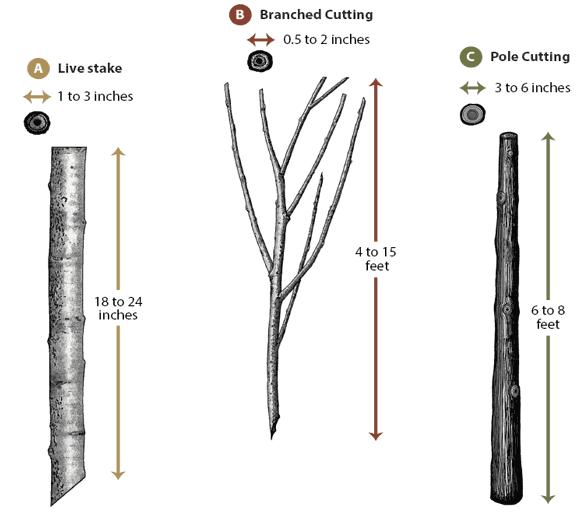
Figure 5-72 | Different cutting types serve unique purposes in revegetation
Several types of hardwood cuttings can be obtained from stooling beds, including cuttings for propagation at the nursery or live stakes and branched cuttings for restoration projects. Note that larger plant materials require extra time to produce.
Develop Timeline
Obtaining cutting materials from established stooling beds takes between one and five years, depending on the type of material. A minimum of one year is necessary to produce branched cuttings; two to four years to produce live stakes; and pole cutting may require more than four years (Figure 5-73). In the planning stages of the revegetation project, the number, type, and species of cuttings needed for the project should be determined. Procedures for making these calculations are outlined in Section 5.3.2, see Determine Cutting Needs. Nurseries or government facilities that specialize in stooling bed production can be contacted to see if they will establish stooling beds for the project. Managers of these facilities can provide information regarding costs and the time frame for meeting the orders. While some cutting materials will be produced in the first year, full production of stooling beds does not occur until several years after installation.
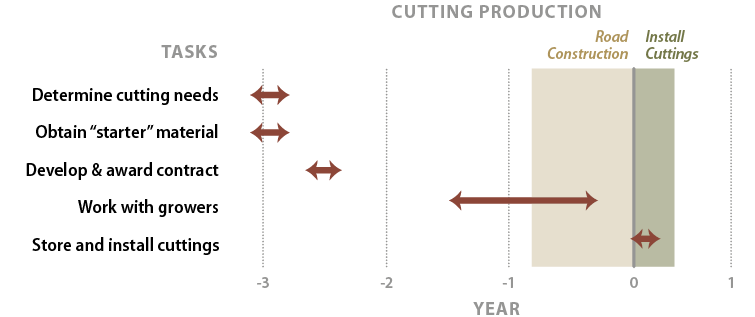
Figure 5-73 | Plan early to ensure cuttings are ready for a project
Obtaining cutting materials from stooling beds can take up to four years, depending on the type of material requested. Branched cuttings can be obtained from stooling beds after the first growing season, while live stakes can take from two to four years. Pole cuttings can take even longer. The following is a timeline for producing branched cuttings and some smaller live stakes. Add several years for large stakes and some poles.
Most stooling beds are started from cuttings taken from the wild. The sources of starter material should be located in the field during the summer or fall prior to installation of the beds. The sexual identity of dioecious plants should be determined during the appropriate season prior to collection. This is not a simple task and requires the expertise of a skilled botanist or native plant specialist. Section 5.3.2, see Locate Cutting Areas provides an outline of the steps necessary to obtain starter material. The nursery managers will provide information regarding the number of feet of starter material (or number of cuttings), the quality of the wild collections (age, size, condition), and packaging and shipping methods necessary to meet the order. Wild cuttings are collected when the donor plants are dormant (i.e., no leaves present). Depending on the climate of the site, collections can begin in mid to late fall and end from late winter to mid-spring. Wild cuttings are usually sent immediately to the nursery where they are prepared for installing in stooling beds. Most stooling beds are started directly from cuttings that are stuck in the spring. Cuttings root quickly in the spring and, with irrigation and fertilization, grow into large plants by the end of the summer. The following winter, the beds are ready for harvest. Because stooling beds are relatively uniform, the material can be harvested and processed in a production-oriented manner. Cutting materials are cut to specifications and stored in either freezer or cold storage facilities until delivery is requested.
The development of stooling beds is a long-term investment, and they often take several years to fully establish. However, they can remain productive for many years depending on species, ecotype, nursery cultural practices, and pest management. For cottonwoods, stooling beds typically remain productive for four to eight years, after which vigor and productivity start to decline. Importantly, cuttings from declining beds can be used to create new beds ensuring the preservation of individual genotypes and this eliminates the need to return to the original source location in the field. However, other nurseries have maintained stooling beds of willow and cottonwood for 12 to 15 years without decreases in vigor. Cytospora canker, caused by fungi of the genus Cytospora spp. (Figure 5-72B), is a particularly serious pest of all Salicaceae and, because it is transmitted and thrives in wounded stem tissue, can ruin a productive stooling bed. The productivity and longevity of a stooling bed are a direct function of the amount of care given. Because stooling beds are an investment with long-term payoffs, finding local partners (watershed councils, federal, state, and county land managers) who can utilize these beds after project needs are met can be a service to the local community.
5.3.6 Nursery Plant Production
Introduction
Planting stock with established root systems is often optimal for certain species, or for use in restoration projects that occur on very harsh or disturbed sites. This may be accomplished by growing plants from seed or rooted cuttings in nursery beds or in containers in a greenhouse for a period of time ranging from several months to several years. Woody plants are critically important because they quickly provide vertical structure and aesthetic relief on roadside revegetation projects. When planted within areas seeded with grasses and forbs, trees and shrubs provide the essential matrix of a successful revegetation project. Direct seeding is rarely used to establish woody plants on restoration projects because they are often slow to germinate and take several years to become established. Depending on site characteristics, many sizes of nursery stock can be used. If large plants are used, their physical size and deep roots allow them to more quickly access soil moisture at deeper levels, and their expansive lateral root systems help stabilize soils while also reaching more surface moisture. On some harsh rocky sites, smaller plants may have better initial survival and are more likely to colonize the area. In addition to providing wind protection and shade to lower growing vegetation, trees and large shrubs provide habitat for insects, birds, and other animals and can greatly accelerate the development of a sustainable plant community.
Grasses and forbs establish quickly and easily from seeds, so they are less frequently grown in nurseries. However, nursery stock is warranted under certain circumstances including the following:
- Sufficient quantities of grass and forb seeds are rare or hard to collect;
- Increasing grass and forb seeds by seed growers is difficult or excessively expensive;
- Establishing grasses and forbs is difficult due to site conditions;
- Restoring threatened or sensitive species is a high priority;
- Using nursery stock is more effective in restoring wetlands;
- Installing nursery stock is the best and fastest way to achieve a desired plant composition;
- Aggressive weeds are a serious problem.
This report outlines the steps needed to obtain quality seedlings, transplants, or rooted cuttings from native plant nurseries. Typically, it takes one to two years to grow nursery plants; therefore, the designer should develop growing contracts and establish timelines several years in advance.
Develop Timelines
For the Designer
When investigating plant material sources, designers can enlist the assistance of plant geneticists to help determine if a given source is genetically appropriate for a certain project area.
Obtaining some nursery stocktypes can take a considerable amount of lead time and planning. Although most native plant nurseries carry a wide variety of species, it is unlikely they would have plants that are genetically suitable for a specific project. However, it is worth investigating the available sources for genetic appropriateness as this can save time and funding. The large nursery stocktypes that will survive and grow on challenging restoration sites typically require several years to produce (Figure 5-74). It is therefore often necessary to develop contracts that will ensure that the correct genetic material is being propagated and that the resulting plants are of the highest quality that will survive and grow when planted on the revegetation site.
A project's plant needs are determined early in the revegetation planning stages, including the number of plants, types of species, and size of plants. From the list of species, seed sources or "starter" plant material sources are located from suppliers or collected in the wild. This can typically take at least a year. Several years before the construction site is ready for planting, a contract for growing plants is developed and awarded. Once awarded, seeds and "starter" plant materials are sent to a nursery so that sowing, transplanting, or rooting of cuttings can begin.
The growing time for large container stock can extend from one to two years, depending on the species. The nursery will take a final seedling inventory during the middle of the final growing season. At this time, a planting plan can be finalized. Road construction will be moving into its final stage and the planting plan can be tailored to specific on-site conditions. From start to finish the whole process, including lifting, storing, and transporting plant materials, can take two to three years.

Figure 5-74 | Engage nurseries early for plant materials
Obtaining nursery-grown plants often requires two to three years of advance planning, although the timeline for different species can vary considerably. This timeline can be shortened by up to a year if "starter" plant materials, such as willow cuttings or seedlings for transplanting, are available. Certain woody plants require long seed treatments or grow slowly, so timetables should be adjusted accordingly.
Determine Plant Needs
Early in the planning stages, a general idea of plant needs is developed based on the desired future condition for each revegetation unit. The information required to determine the quantities for each revegetation unit includes the following:
- Area to plant
- Species mix
- Survival potential
- Plant spacing (density)
Using calculations similar to those presented in Figure 5-75, an estimate of the number of seedlings to order from nurseries can be determined. Calculations should be performed for each revegetation unit, because species mix, plant spacing, and survival will change considerably between units.
Planting Area—Summarize the acreage of all planting areas within each revegetation unit.
Species Mix—Good survival and establishment of plants fundamentally rests on selecting the most appropriate species from locally adapted seed sources. Selecting the species mix for each revegetation unit should be based on an evaluation of disturbed and undisturbed reference site descriptions that includes an understanding of the site limiting factors that will affect plant survival.
A |
Planting area |
0.75 acre |
Area that will be planted |
B |
Target plant spacing |
8 feet |
Desired distance between established plants |
C |
Avg. survival potential |
75% |
Percent of seedlings that survive after one growing season |
D |
( A * 43,560 ) ( B * B ) = |
510 plants |
Desired number of established plants after one growing season |
E |
D * ( 100 / C ) = |
681 plants |
Number of nursery plants that need to be planted |
Species mix |
|||
F |
Ponderosa pine (PIPO) |
50% |
Percent of total established plants composed of PIPO |
G |
Quaking aspen (POTR5) |
30% |
Percent of total established plants composed of POTR5 |
H |
Serviceberry (AMAL2) |
20% |
Percent of total established plants composed of AMAL2 |
I |
E * F / 100 = |
340 plants |
Number of PIPO to order |
J |
E * G / 100 = |
204 plants |
Number of POTR5 to order |
K |
E * H / 100 = |
136 plants |
Number of AMAL2 to order |
Figure 5-75 | Determining planting needs
A spreadsheet can be used to determine how many plants should be ordered for each species. Each revegetation unit should have separate calculations because the units will have different survival rates, species mixes, and plant spacing.
Survival Potential—Survival potential is an estimate of the percentage of planted seedlings that will survive and become established. Many factors determine how well nursery-grown plants will survive after outplanting. Factors that can be controlled include the following:
- Selection of appropriate species and seed source for the site;
- Quality of nursery plants;
- Appropriate storage and transportation conditions;
- Care in stock handling and planting.
High rates of plant mortality are usually the result of an oversight or neglect of one or more of these factors. Projects with high plant mortality may indicate poor planning or implementation. However, aiming for 100 percent survival is often unreasonable because of the high associated costs. Most projects should aim for a plant establishment rate of 85 to 90 percent, but plan for 75 percent. It is more economical to plan for some small extra plants and care now to insure adequate survival up front, than to be faced with a new plan for additional plant material growing and planting at a future date.
There are many reasons why plants may not survive on a project site and one of the most important considerations to address is seed source and genetic appropriateness. If genetic considerations are not addressed and a planting fails, the designer cannot identify possible causes because seed source will confound all other aspects.
Target Plant Spacing—The target plant spacing is the desired distance between established plants. The spacing or density of established plants is an estimate that should be based on site productivity and project objectives. The reference sites can be reviewed to determine the densities and species mix a site could support. Note how the different plant species are naturally spaced on each reference site. Some grasses and forbs exhibit uniform spacing, but many woody plants have a more random or clumped pattern.
For example, an undisturbed reference site description shows that an average density for an established stand of trees is 500 trees/ac, with a species mix of 80 percent ponderosa pine and 20 percent quaking aspen (density can be converted to plant spacing by taking the square root of 43,560 divided by plants per acre). The selection of species often determines the planting densities. Shrubs, for example, typically grow at much closer spacing than trees, and this should be considered when species mixes are determined for a revegetation unit.
Revegetation unit objectives often require higher plant densities than typically occur on reference sites. Quick visual screening as the overriding objective will require high-density planting. Selecting a higher plant density than typically occurs in the project area should be done with some projection of how the area will appear many years later. High-density planting can create overstocked stands of trees within 10 or 20 years of planting (Figure 5-76). Overly dense stands often lead to stressed trees and high fire hazard conditions, and could require thinning at a later time. Furthermore, dense stands of vegetation adjacent to roadways can provide cover for wildlife, resulting in conflicts with vehicles. In Oregon a clear zone off the roadway is kept with only low growing vegetation.
![]() 1,500 trees/acre
1,500 trees/acre
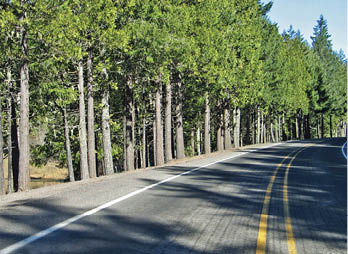
![]() 250 trees/acre
250 trees/acre
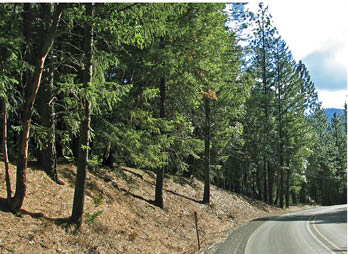
Figure 5-76 | Determining plant spacing
Determining plant spacing should be based on short- and long-term objectives. Where the short-term objective is quick visual screening and site stabilization, high-density plantings of 1,500 trees/ac (A) will produce the short-term desired outcome. These trees may need to be thinned to reduce competition to avoid creating an unhealthy stand of trees with a high fire risk. Reducing tree densities to 250 trees per acre will produce a mature stand of trees (B). Planting at these lower densities will reduce the need for thinning, but tree cover will take longer to dominate the site.
Photo credit: David Steinfeld
Select Stocktypes
Plants are grown, or cultured, in a variety of ways—indoors or outdoors, in native soil or artificial media, and for several months or up to several years. The nursery industry categorizes plants into "stocktype" groups based on plant age, size, and morphology. The "American Standard for Nursery Stock" provides a good summary of stock types and is considered the definitive reference for ensuring that plant size and container type conforms to the accepted industry standard. The American Standard for Nursery Stock deals primarily with commercial nursery stock and less with native forbs or shrubs. Individual stocktypes can be defined by the following:
- Plant type (bareroot or container)
- Years in the nursery
- Size or shape of the container for container stock
Plant Type—Nursery plants are grown in containers or bareroot in open fields. Bareroot seedlings are lifted from the nursery with their roots freed from the soil in which they were grown, while container stock is outplanted with its original nursery soil medium. Understanding the benefits and limitations of each system relative to the planting site can help designers choose the best plant types for success.
Root depth and configuration are important factors in successful seedling survival and site colonization. Bareroot seedlings often have a large, hardy shoot and root mass. This typically larger stem caliper and seedling hardiness may better withstand damage from animal browse than container stock. Root systems of bareroot stock are often limited to 12 inches or less due to culturing practices. In contrast, the wide variety of available container shapes and sizes provide the ability to develop target container seedlings with the optimal root mass based on the species and planting site conditions. The large root mass of bareroot seedlings can more readily colonize in native soils, but can be more difficult than container stock to plant in rocky, shallow soils. The fine roots more typical of container stock allow improved water and nutrient uptake, which is particularly important on drier soils.
Bareroot seedlings require more specialized handling and storage procedures than container stock. This can present challenges where timing of outplanting is variable or proper equipment is limited. Typical operations for bareroot seedlings include lifting in the winter (or before the ground freezes) and subsequent storage for several months. This may limit the planting window from early winter through late spring. Once they are lifted, bareroot seedlings must be kept in coolers at the proper temperature and humidity to prevent respiration and mold development prior to planting. Operationally, container seedlings can be extracted, packed, and stored in a similar manner to bareroot. However, they may also be left in containers until planting is imminent allowing more flexibility in meeting operational timelines for planting. This allows for extending the planting season, or postponing until the following season if necessary. This method requires additional space for transport and storage, but eliminates the need for coolers and specialized handling.
Although bareroot seedlings are usually less expensive than container stock, for most roadside revegetation sites, container stock is recommended. Container stock is usually more appropriate for highly disturbed project sites. They are better suited to take advantage of limited soil moisture, which is a common limiting factor on these sites. The size and scale of these projects often require small numbers of multiple species which are more appropriate for container seedling production. The extended planting window, often necessary to meet dynamic project timelines is more easily met using container stock.
Container Size—The size and age of a nursery-grown plant are controlled by the size of the container. Typically, the larger the container, the larger the plant and the longer it takes for roots to fill the container. In Figure 5-77, plants are grouped into broad categories based on how fast they typically fill out various container sizes. Many deciduous tree species, which include willows, cottonwoods, maples, alders, and ash, tend to be very fast growing species and can fill out a range of container sizes in just one growing season. Conifer species (firs, pines, cedars, and hemlocks) will fill smaller containers the first year and can be transplanted into larger containers for another one or two growing seasons. Faster-growing shrub species (ceanothus and bitterbrush,) are often grown in small containers in the spring and transplanted into larger containers several months later. They will fill a ⅛ to ½ gallon container in one growing season. Slower growing shrub species should remain in the smaller cells for a full growing season before transplanting.
Container Sizes |
Years in Containers |
||||||||||
in3 |
Gallon |
1 |
2 |
3 |
|||||||
Evergreen Trees |
Deciduous Trees |
Fast growing shrubs |
Slow growing shrubs |
Evergreen Trees |
Deciduous Trees |
Fast growing shrubs |
Slow growing shrubs |
Evergreen Trees |
Slow growing shrubs |
||
10-20 |
— |
yes | yes | ||||||||
30 |
1/8 |
yes | yes | yes | yes | ||||||
60 |
1/4 |
yes | yes | yes | |||||||
115 |
1/2 |
yes | yes | yes | yes | ||||||
230 |
1 |
yes | yes | yes | yes | ||||||
460 |
2 |
yes | yes | yes | yes | yes | |||||
925 |
4 |
yes | yes | yes | |||||||
Figure 5-77 | Carefully consider container size
Native plants have differing growth habits and rates; therefore, it is important to match container size with species growth characteristics. Shaded blocks represent recommended container sizes for each species type in years 1, 2, and 3.
Container Design—Container shape is also an important consideration in stocktype selection because it determines how easily the root plug is extracted from a container, the degree of root spiraling, what planting methods will be used during installation, and ease of handling (i.e., form factor). The depth and taper of the container walls govern how easily a root plug can be extracted from its container. Generally, the greater the taper, the easier a root plug can be extracted. Taper becomes more critical as container walls become longer with respect to the diameter of the opening. Straight-walled "tall pots," made from PVC pipe, are very long in comparison to the diameter of the opening. Root plugs from this container are difficult to extract without the placement of Vexar tubing inside the container. Pulling the Vexar tubing during extraction brings out the entire root plug without undue stress to the stem or root system. Other nurseries offer tall pots with the PVC pipe cut in half lengthwise and held together with electrical ties. Before planting, the ties are cut, which allows easy access to the root system.
Several container design features affect root development and plant quality. When plant roots grow out and hit the sides of the container, they often grow downward in a spiral pattern. When roots reach the bottom holes, they should "air prune." If kept too long in the container, the circling roots will eventually form a tight mesh which, after outplanting, can continue to circle and "strangle" the plant. Most containers have vertical ribs that guide roots down the sides of the container walls to prevent root spiraling. Some smaller containers feature copper coating on their walls to chemically prune the roots as they grow. Other container walls have vertical air slits that air prune the roots. When container roots are so cultured, the root system is more fibrous with more root tips which allows for vigorous growth when planted.
Root condition is a critical factor to discuss at the time that growing contracts are being developed. Roots that have excessive spiral growth should be pruned before they are planted. This is most easily done at the nursery during harvesting. This extra processing step should be stipulated in the growing contract.
Matching Nursery Plants to Outplanting Site—A wide variety of nursery stocktypes are available (Figure 5-78). Site factors should be considered before placing an order. The depth and width of containers are very important for seedling survival and growth. Sites with low precipitation during spring, summer, and fall should be planted with larger container sizes. Where soil moisture-holding capacities are low or vegetative competition for soil moisture is high, long containers should be considered. Where rock content is high and it is hard to excavate a planting hole, shorter container stocktypes should be used. Additional post-planting care should be implemented to compensate for shorter roots (Section 5.4.4). The planting method dictates the size of the root plug. For example, the expandable stinger and power augers require plug diameters no greater than 4 inches. Large seedling stems and tops are required where animal damage is expected.
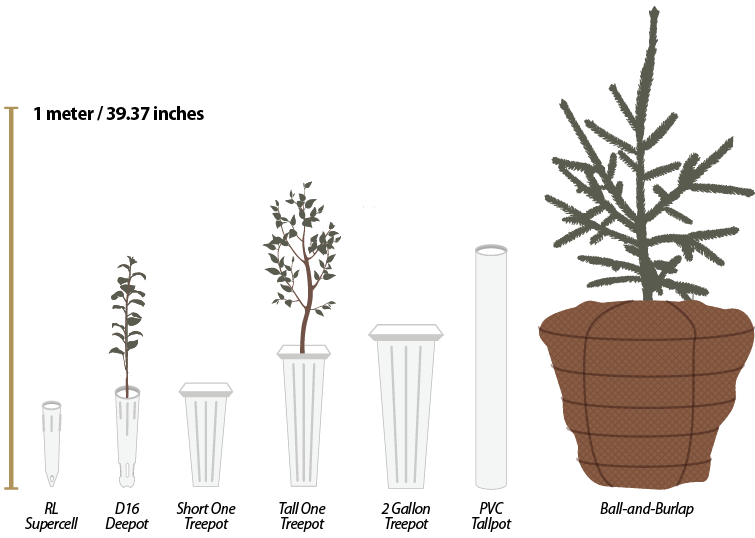
Figure 5-78 | Match stocktype to site conditions and planting method
Nurseries can produce plants in all shapes and sizes. The best stocktype for a project will depend on site conditions and time and method of planting.
Stocktype selection often determines seedling survival rates and how fast they grow in the first years after planting. Typically the larger the root system, the better the survival and growth. Larger stocktypes cost more, so it is important to target the stocktype to the needs of the site and the revegetation objectives. For example, if quick establishment of vegetation for visual screening is an important objective, then a large stocktype would be ordered. Alternatively, if a revegetation unit is relatively unseen and the site has few limitations to plant survival, a small, less expensive stocktype would be ordered. While larger stocktypes are generally more expensive than smaller stocktypes, the total costs of establishing seedlings should be considered before settling on a smaller plant. Costs for replanting a site where smaller seedlings died in the first year can be far more expensive than planting larger plants in the first place.
Years in the Nursery—Bareroot stocktypes are often defined by the years they are grown at the nursery, whereas container plants are typically described by the size of the container. This is important when ordering plants because many species take longer than one year to grow to the desired plant size. If plants are needed for a project within one year, the designer will need to order smaller size containers to ensure that the roots can fill the plug.
Unbalanced or Holdover Stock—A common mistake is growing container plants with tops larger than the root system can support. This is often the result of poor planning, delay of projects, or poor selection of stocktype. For example, road projects are frequently delayed for a year, leaving the designer with the problem of what to do about the seedlings that are being grown. Typically under these circumstances the nursery manager is asked to hold the seedlings in the same containers an extra year. While most will comply, they will do it reluctantly. The result is plants that are top heavy—the shoots are too large for the root system to support (Figure 5-79A). The results are often deceiving. The plants have not shown stress because they have been pampered under greenhouse conditions and care. Yet, once seedlings are outplanted on a typical harsh site, the plants will struggle to grow enough roots to keep the tops healthy and alive. Plants respond to the lack of moisture in what is referred to as "transplant shock (Figure 5-79B) by shutting down growth and often turning yellow or "chlorotic." Roadsides are stressful sites that require the very best quality plant material. A good example of the difference between well balanced and poorly balanced nursery stock is shown in Figure 5-80.
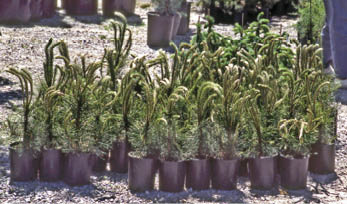
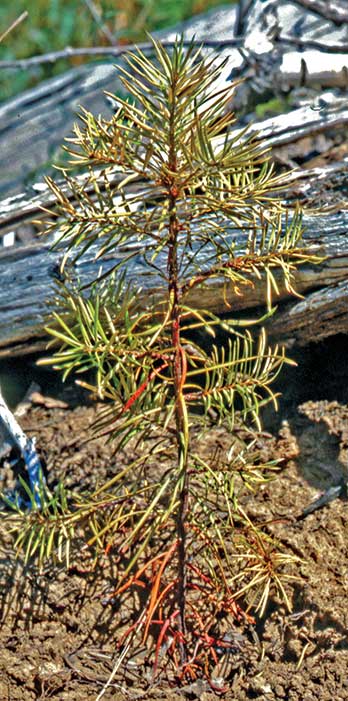
Figure 5-79 | Well-balanced nursery stock
The shoots of these pine seedlings have grown too large for the size of the root system which increases moisture stress after planting. In addition, the buds have broken dormancy, which means the plants will not tolerate rough handling (A). Poorly balanced or conditioned nursery stock will struggle to survive and grow after planting and exhibit signs of "transplant shock" (B).
Photo credit: Thomas D. Landis
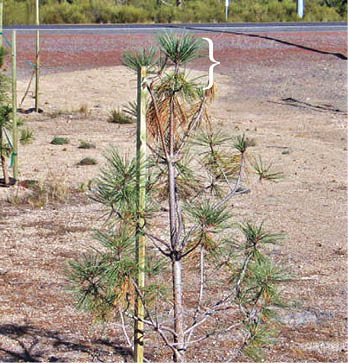
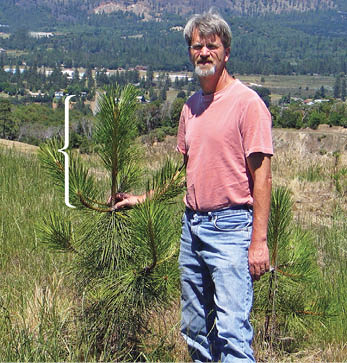
Figure 5-80 | Effects of transplant shock can last years
The ponderosa pine seedling (A) was grown for four or five years at a nursery and outplanted on a semi-arid site. The photograph was taken one year after outplanting and shows the seedling has undergone transplant shock due to the imbalance, or high shoot to root ratio, of the seedling when it was planted. The seedling was root-bound when it was planted. The tree responded by dropping most of its nursery needles and grew very little in height in the first year. A different ponderosa pine seedling (B) was grown in a one-gallon container for one year, then outplanted. Because this seedling had good balance and was not root-bound, it did not undergo transplant shock after it was outplanted. After two years, this seedling is well established. The brackets in both photos show the current year leader growth.
Photo credits: David Steinfeld (A) and Greg Carey (B)
Delays are common in roadside projects, so two viable options can be considered: transplant the stock into larger containers or reject the plants and place a new order. Option one is appropriate if the plants are being grown in small containers and a larger container is available for transplanting. If growing plants in a large container, it makes little sense to transplant into a still larger one. This option is often more costly than option two, which is to start over with the order, but starting over assumes available seeds and other starter plant materials are available and there is enough time to reorder. For plants that are not used, the designer or nursery manager can contact land managing agencies and landowners in the general geographic area to determine if they are interested in these plants. If not, watershed councils or environmental groups often appreciate the donation of such plants for their projects.
Develop Growing Contract
All nurseries experience weather extremes, insect or disease losses, equipment failures, and other production problems that can severely decrease the quantity and quality of the stock. Therefore, it is a good strategy to reduce these inherent risks by growing plants at more than one nursery. In doing so, the strengths and weaknesses of each nursery can be determined, which is helpful for future orders.
Nursery Selection—Very few nurseries will offer plants from source-identified plant materials specific to a project, even in geographic areas of the country with an abundance of nurseries that grow native plants. Obtaining genetically appropriate plants will require finding nurseries willing to grow seedlings from specified genetic material. A current national list of native plant nurseries can be found online in the National Nursery and Seed Directory. See Inset 5-17.
Inset 5-17 | Forest Service Nurseries—Dorena Genetic Resources Center
US Forest Service Nurseries have a long history of growing plants that are genetically appropriate and locally adapted for use in reforestation and restoration of public lands (Dumroese and others, 2005). These nurseries also establish new growing protocols, continue to improve cultural practices, and provide technology transfer in seedling production and quality. While the focus of most nurseries is on plant production, the USFS Dorena Genetic Resource Center (Cottage Grove, OR) nursery has expanded its services to more effectively accomplish restoration to meet the needs of its diverse clientele. Dorena has become the primary plant development center for the USFS Restoration Services Team (RST), created in partnerships with Western Federal Lands and OR and WA State Departments of Transportation. This membership in the RST is the driving force for expanding the nursery capabilities to a full service restoration center.
The restoration species at right are grown at the USFS Dorena Genetic Resource Center nursery and used on RST restoration projects.
Dorena offers complete services beginning with project initiation through successful site restoration. Beginning with project consultation, including recommendations on stocktypes, species mix, plant quantities, and timing, their staff provide knowledgeable input matching plant materials to the client's specific project needs. Following this initial consultation, a range of other services are available to help clients fulfill their project objectives. These include the following:
- Assistance in on-site seed and vegetation collection;
- Container plant production of native conifers, hardwoods, shrubs, forbs, and grasses;
- Development and technology transfer of propagation protocols for species without established growing regimes;
- Specialize in small quantity, multiple species orders, and difficult to grow species;
- Consultation and assistance in outplanting including development of innovative tools and techniques;
- Full range of project monitoring design and implementation;
- Assistance with restoration project management through the RST.
Dorena continues to strengthen and expand its partnership base and its role in providing innovative solutions to current biological challenges. For example, current emphasis on pollinators has resulted in Dorena growing a variety of plant species specific to enhancing pollinator habitat. The nursery continues to adapt to new challenges in meeting the changing needs of restoration.
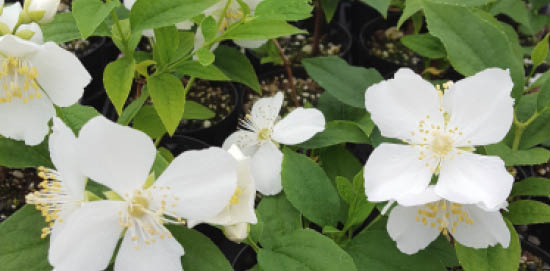
Mock orange Philadelphus lewisii
Photo credit: Lisa Winn
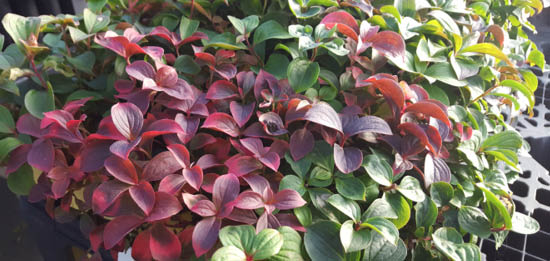
Bunchberry dogwood Cornus canadensis
Photo credit: Lisa Winn
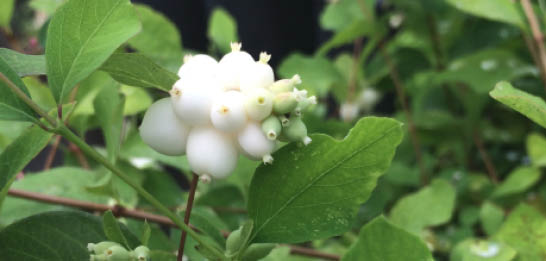
Snowberry Symphoricarpos albus
Photo credit: Lisa Winn
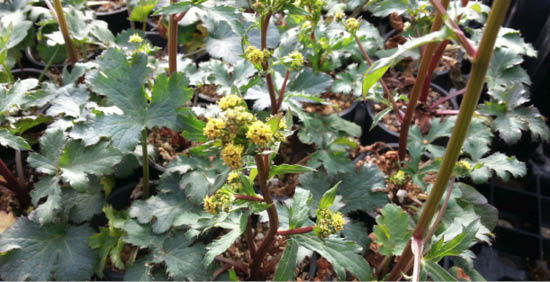
Coastal black snakeroot Sanicula laciniata
Photo credit: Clare Gilmour
When considering a nursery for plant production, consider the following factors:
- Proximity—Is the nursery close enough to visit occasionally?
- Service—Is the staff easy to contact? Do they promptly return phone calls or e-mails? Are they friendly and helpful?
- Expertise—Are they knowledgeable in restoration and revegetation?
- Years in business—Has the nursery been in business for at least three years?
- Seedling quality—Is the overall seedling quality high?
- Seedling quantities—Are the orders regularly met or do they consistently run short?
- Price—Are prices competitive?
- Willingness—Will the nursery try new things?
If there are doubts about one or more of these factors, consider using another nursery. Ultimately, the selection comes down to personal experience with nurseries and word-of-mouth from other designers.
Seedling Orders—A plant production contract should detail the information developed in previous sections of this chapter:
- Species
- Genetic source
- Starter plant material
- Stocktype
- Net amount of plants
- Month and year for plant delivery
- Minimum seedling specifications
- How they will be processed and stored
A few phone calls to nurseries will provide an idea of which nurseries will grow the species, stocktype, and quantities necessary for the project. Nurseries can still be used if they can only meet a portion of the order. Other nurseries can produce the remainder because there is less risk by sending plant orders to several nurseries. Contracts can be developed once it is known what portions of an order a nursery can produce.
Plant Processing and Storage—Once seedlings have reached the target size and age at the nursery, they are harvested, stored, and processed for shipping. If the plants are bareroot seedlings, they are lifted from the soil, graded, and packaged. Container seedlings can be extracted from the containers, graded, and packaged, or sent to the planting site in containers and extracted immediately before planting. Either way, most stocktypes will be held at the nursery for one to six months, depending on when they are needed for planting. "Planting windows" are described in more detail in Section 5.4.4.
Storage times are longest for seedlings planted in the late winter and spring. For these orders, plants are extracted from their containers or lifted from the soil in the winter when they are least susceptible to the stress or damage associated with extraction, handling, and packaging. Plants in this condition are dormant. The onset of plant dormancy for deciduous plants is often around the time when plants have lost their leaves in late fall; the end of dormancy begins just before the buds begin to swell in late winter to spring. The dormancy period for conifer species is not visibly discernible, but typically follows a similar time frame as deciduous species. Seedling dormancy in the western United States typically extends from December through February, but the dates will vary by nursery. If plants are to be extracted and held in cold storage for long periods, it is important to know when the nursery is extracting and handling the seedlings to be sure these operations are done when seedlings are dormant. Seedlings that are extracted or lifted outside the seedling dormancy period and stored for any length of time will survive and perform poorly.
When plants are lifted from bareroot beds or extracted from containers, they are also being graded for size and appearance. Unless otherwise agreed, the size specifications stated in the contract will be the grading criteria (Figure 5-81). It is helpful to be at the nursery during lifting/extraction and grading to see which seedlings are being thrown away and which seedlings
are considered shippable. Bareroot and smaller container plants are graded and boxed for refrigerated or freezer storage. Storage containers will have important information about the plants, such as seedlot, date packed, client name, and the number of seedlings in the container. Plants are typically held in cooler storage (32 to 35 ° F) from a few weeks to two months. If longer storage is required, freezer storage (28 to 31 ° F) is recommended to maintain seedling quality and reduce the chance for storage molds.
Large container stocktypes (typically those equivalent to a half gallon or larger) are stored and transported in the containers in which they are grown. They are typically stored in shadehouses or other sheltered storage. In cold climates, the roots should be insulated to protect against cold injury. During unseasonably warm periods in late winter or early spring, large container stock should be monitored for drying and irrigated if necessary.
Grading Specifications—Although it is an excellent resource, the American Standards of Nursery Stock deals primarily with plants of horticultural origins they do not adequately provide standards for the growth patterns of native species. Therefore, you must establish some criteria should be established for accepting or rejecting plants. Being present at the time of packing is the most effective way to negotiate grading standards with the nursery and ensure that quality plants are received.
Typical grading standards can be divided into the following categories (Figure 5-81):
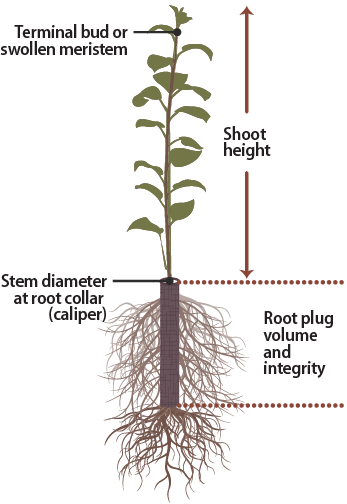
Figure 5-81 | Seedling grading criteria
Grading criteria for seedlings are based primarily on stem diameter, height, terminal bud, root volume, and integrity.
- Root system—The root system of the plant should be examined carefully. A healthy, vigorous root system is one of the most important determinants of plant survival and growth, especially in low rainfall areas and challenging revegetation sites. For bareroot stock, the roots should be well developed and fibrous and approximately the same area as the crown. For container stock, the root "plug" should be firm but not root-bound. Roots should not be spiraled or form a tight mass at the bottom of the seedling container.
- Stem diameter at root collar (caliper)—Stem caliper is another important morphological measure of nursery plant quality and has been consistently correlated with outplanting survival and growth. Diameter is not necessarily a good measurement for rooted cuttings because the size of the stem is dependent on the original diameter of the cutting. A typical grading specification for many bareroot and container stocktypes is a minimum diameter of 3.5 to 4.0 mm for one-year-old seedlings, and greater than 4.0 mm for plants grown for two years. Discuss these specifications with the nursery because not all species will grow to these sizes in this time frame.
- Shoot height—The height of the plant is measured from the root collar, or original ground line, to the top of the terminal bud. Some species do not form a terminal bud, so the swollen meristem tip or even the average top of the crown is used.
- Seedling balance—Nursery stock should have a good ratio between the amount of foliage and the root system. This is traditionally expressed as a shoot-to-root ratio (S:R) and typically ranges from one or two part shoots to one part roots (an S:R from 1:1 to 2:1). This grading standard is a qualitative determination as to whether the root system is large enough to support the above- ground portion of the plant.
- General plant health—During grading, nursery stock should be inspected for physical injury or disease. Root disease is a particular hazard of container stock, and soft or moldy roots should be suspect (Inset 5-18). Scraping the roots with the blade of a knife should reveal white healthy tissue.
Inset 5-18 | Assessing poor quality nursery stock
Poor quality planting stock can be caused by biotic (e.g., diseases, insects) or abiotic factors (e.g., imbalance of soil moisture, temperature, nutrients, and pesticides) in the nursery resulting in detrimental, and sometimes devastating, effects on seedling survival and growth when outplanted. Infection with various pathogens, or biotic causes, may not necessarily be manifested in a nursery but may cause stunting or mortality once seedlings are under stress following outplanting. Designers should be aware of the possible nursery diseases in order to either recognize or discuss with nursery personnel during visits to inspect their seedlings.
Diseases caused by fungi, water molds, bacteria, and viruses can often be difficult to distinguish from damage caused by abiotic events or factors. If damage or chlorosis of seedlings is noted, it is recommended to check with the nursery manager to determine the history of the seedlings, what pathogens are traditionally a problem at the nursery, and what, if any, have occurred during the current growing season. Hamm and others (1990) and Landis and others (1990) provide more detailed information on nursery pests.
Shoot and foliage diseases can be caused by a variety of organisms, with various levels of impact on seedlings. Fusarium hypocotyl rot (caused by Fusarium oxysporum) can cause large losses in the nursery from July through October. Gray mold (caused by Botrytis cinerea) can cause significant damage to densely grown bareroot and container seedlings, as well as nursery stock stored in less than optimal conditions (Hamm and others 1990). The mycelium and gray spore clusters are often easily visible to the naked eye. Botrytis can girdle infected seedlings, increasing mortality rates following outplanting. Minor shoot and foliage diseases, such as shoot blight (caused a number of organisms, including Sirococcus spp., Phomopsis spp., and Phoma spp.) and needle-casts and other foliage diseases tend to deform or stunt seedlings but do not result in significant mortality in the nursery or in an outplanting situation.
Root diseases may be the most insidious of nursery seedling diseases. Because seedlings are cultured under optimum conditions for growth, symptoms are often masked throughout the growing season, manifested only during outplanting stress or drought stress in succeeding years. Most conifers, and many native species, are susceptible to root diseases and root rots caused by Phytophthora spp., Fusarium spp., and Cylindrocarpon spp. These diseases are manifested in the nursery in pockets of symptomatic seedlings or mortality, particularly in areas of poor drainage or previous infestation. Outplanting seedlings infected with these pathogens will result in reduced survival. In addition, transfer of these organisms to outplanting sites may result in infection of the planting area. This specifically is a problem with the root disease Phytophthora lateralis. The spread of this disease from infected seedlings can devastate populations of established Port Orford cedar.
Not all seedling quality problems are caused by biotic factors—many are one-time damaging events that occur during a short span with a regular distribution throughout the field or greenhouse (Mallams 2006). If foliage discoloration, foliage or stem wilting or die-back, seedling stunting, or mortality occur in large patches or over large areas in the nursery, the causes are often abiotic. Outplanting seedlings that have been stunted or damaged in the nursery can reduce seedling growth and survival, as well as increase the time required for site recovery. However, the symptoms of abiotic damage are often more apparent, and the consequences more easily predictable, than damage caused by pathogens.
Although designers have little to do with nursery cultural practices and disease mitigation in the nursery, several options exist to prevent or control disease problems on restoration sites. Disease mitigating measures are similar to insect mitigating measures: (1) only plant healthy stock because weakened or stressed seedlings are more susceptible to diseases both in the nursery and on the outplanting site, (2) plant a variety of species to avoid outplanting failure due to infestation of any single disease, and (3) create a healthy soil environment—seedlings grown on poor sites or on sites outside of the species environmental ranges will be stressed and more susceptible to disease infection.
Administer Contract
The nursery manager should be required to maintain records on how the plants were cultured. The basic information should include date plants were started; the type, rates, and timing of fertilizer applications; irrigation schedules; greenhouse settings (temperature, lighting, humidity); pesticide applications; and any significant problems that might have occurred with the seedlot. The nursery is also required to provide an accounting, or inventory, of the plant orders by late summer.
It is important to visit nurseries at least yearly, but more often is better. These visits will provide an indication of the quality of the stock that will be received and whether the number of seedlings ordered is being met. It also helps strengthen the relationship between the designer and the nursery manager, which often leads to more attention being given to the orders. One of the best times to visit is during the initial plant establishment phase in late spring or early summer after seeds have germinated or seedlings and cuttings have been planted. Stock problems are most likely to be observed at this time. If there is a fall-down in the inventory or the seedlings look unhealthy, this can be discussed with the nursery manager. If caught early enough, there can be time to start more plants. At a minimum, the early identification of problems will provide time to adjust the planting plans and other contracts that depend on the plant inventory.
Another important time to visit the nursery is during the processing of plants for storage or shipment to answer questions that might arise about grading specifications, packaging materials, pruning, and other operations. It also provides a good idea of what type of stock will be received when it is shipped to the planting areas to avoid any unwelcome surprises.

